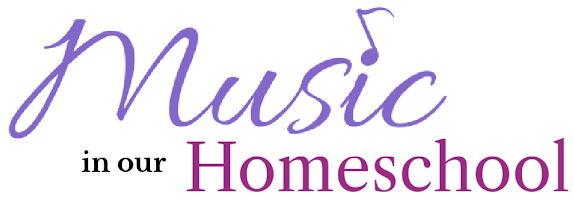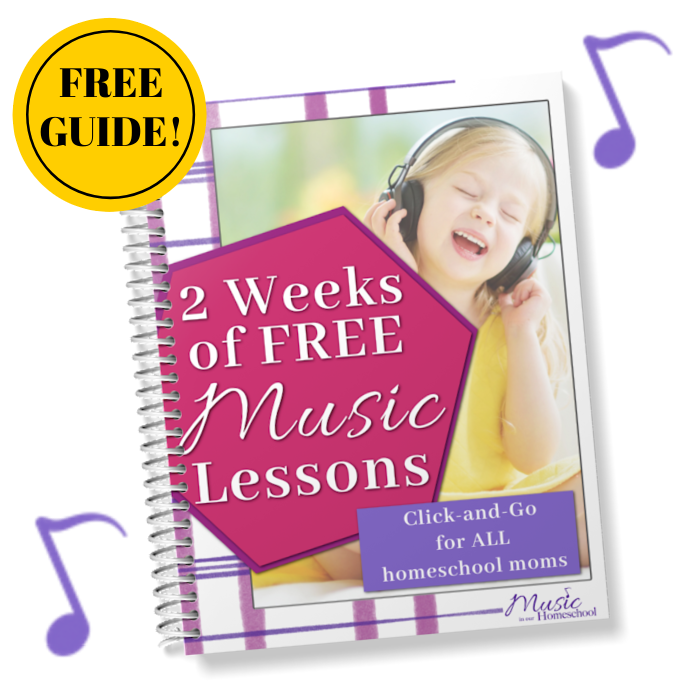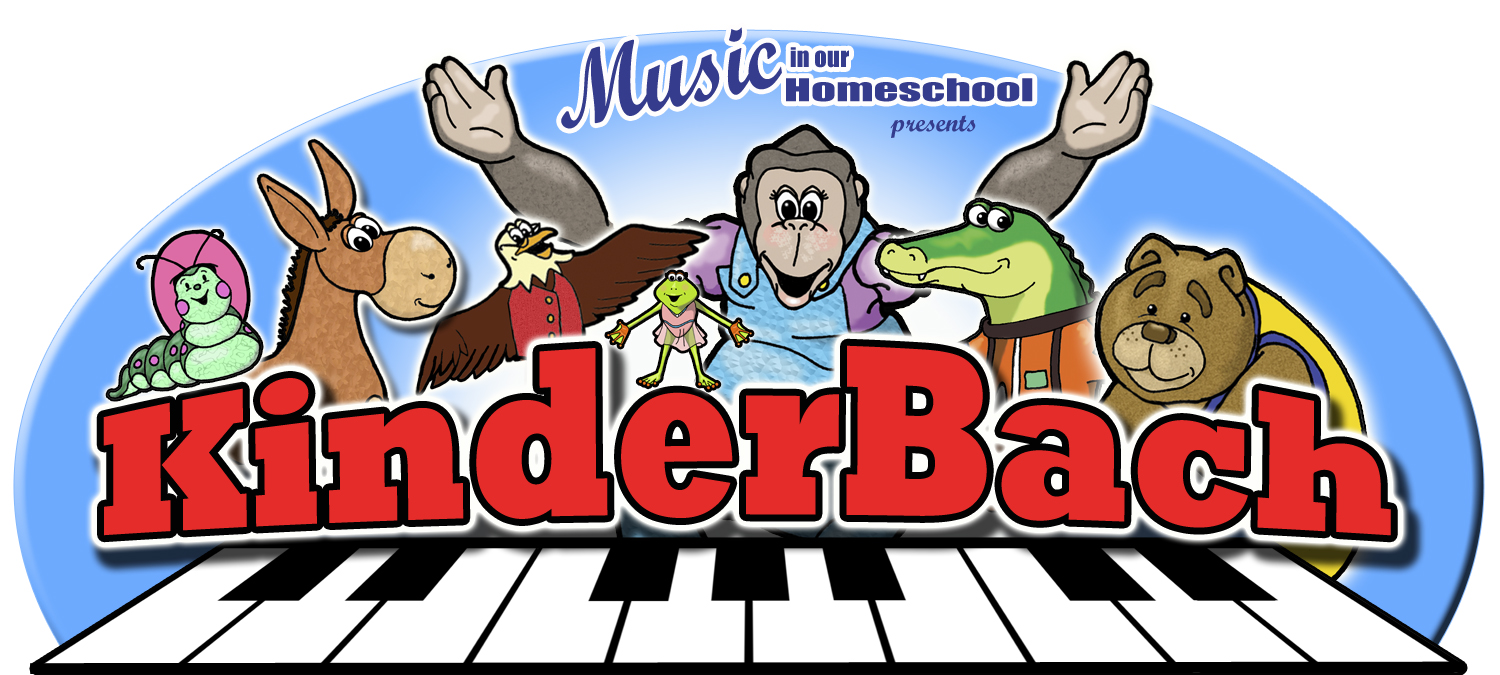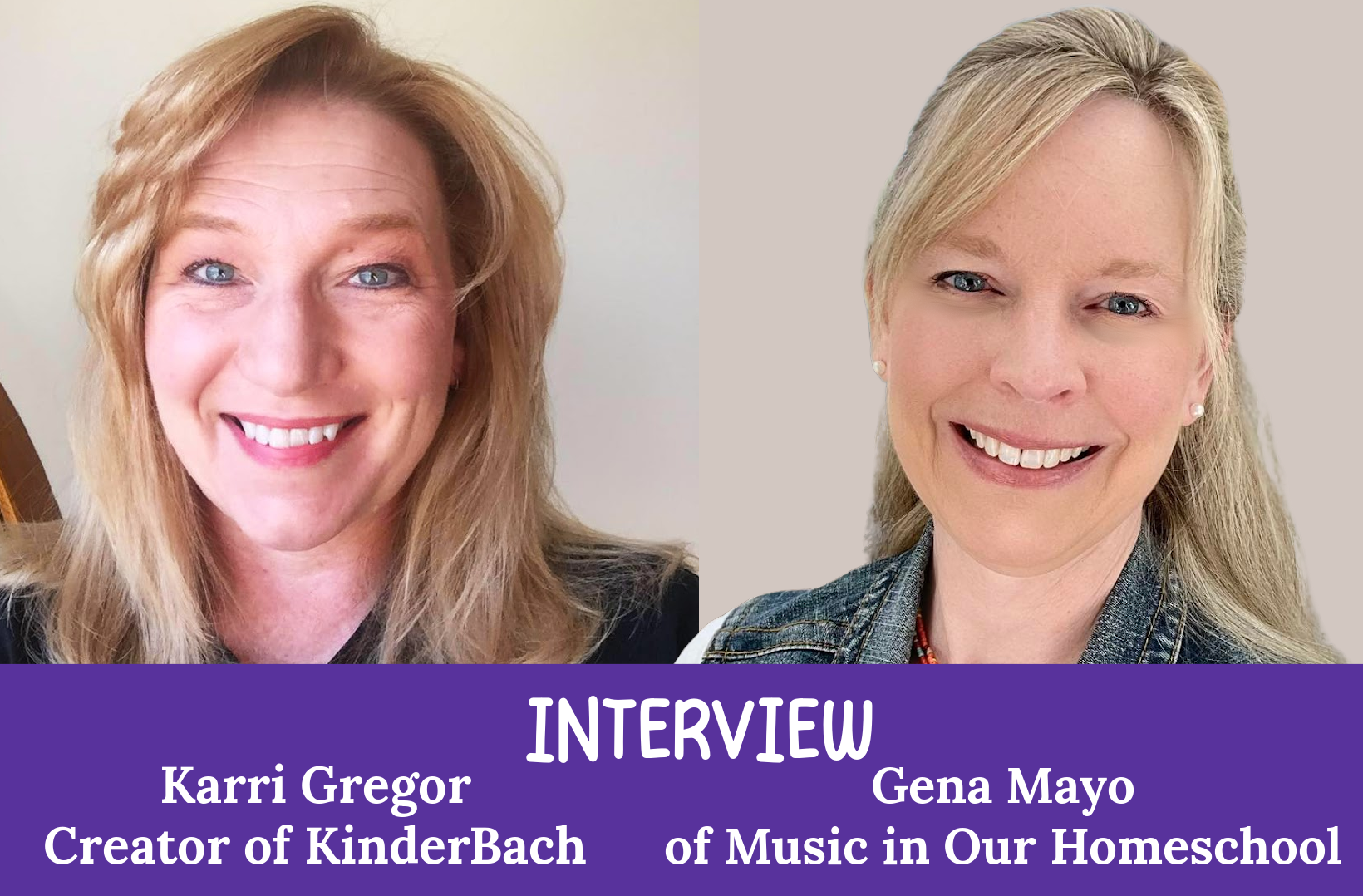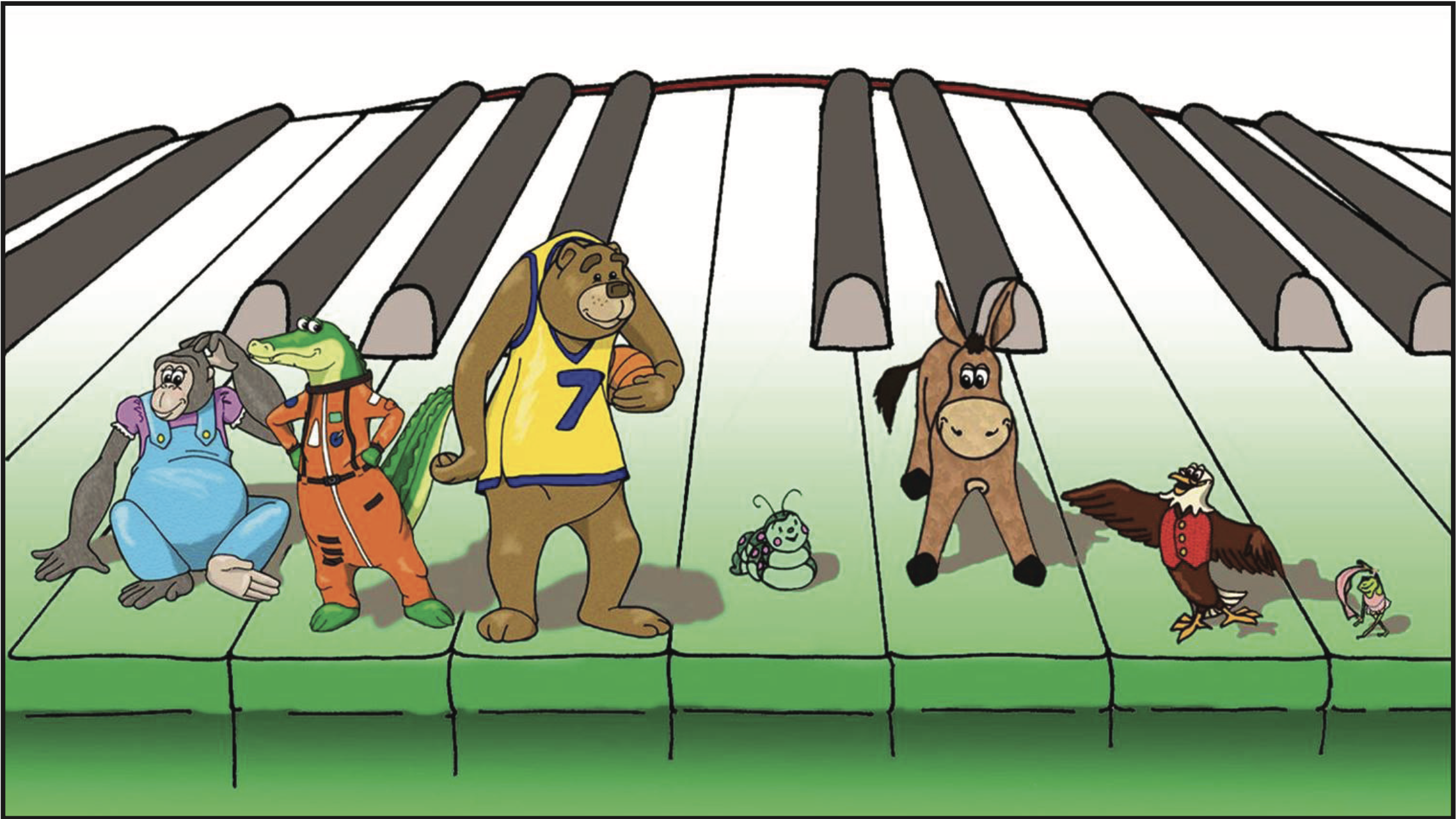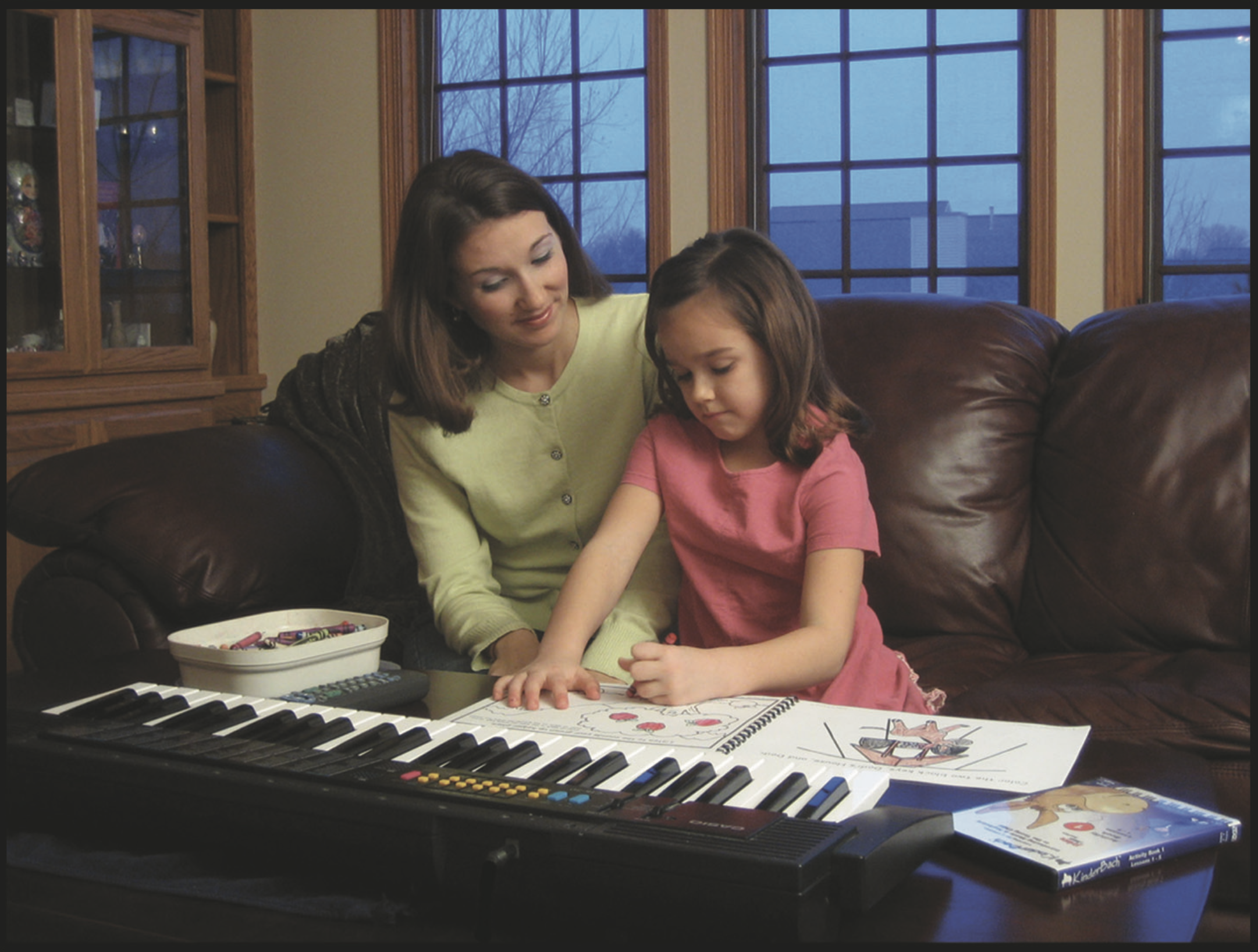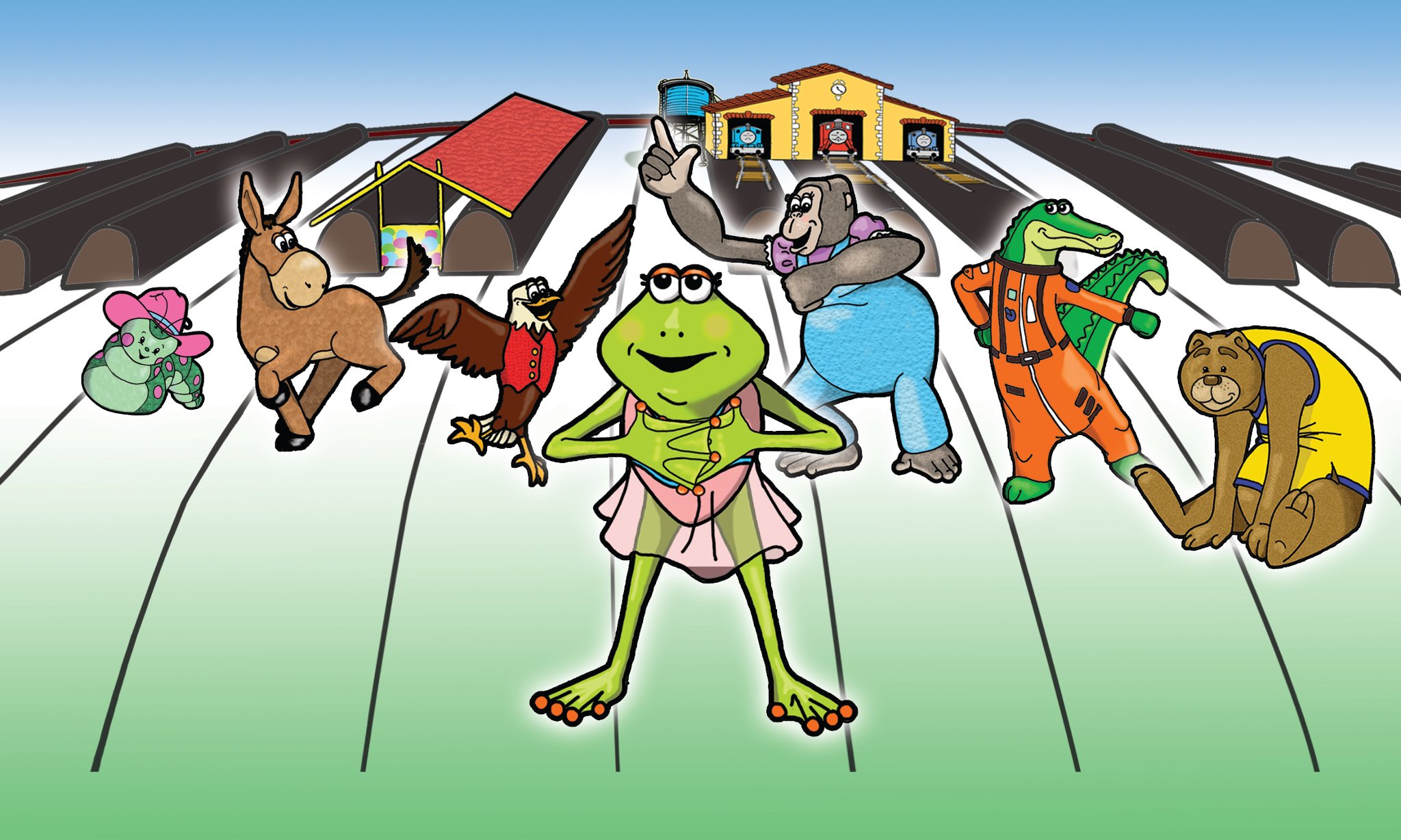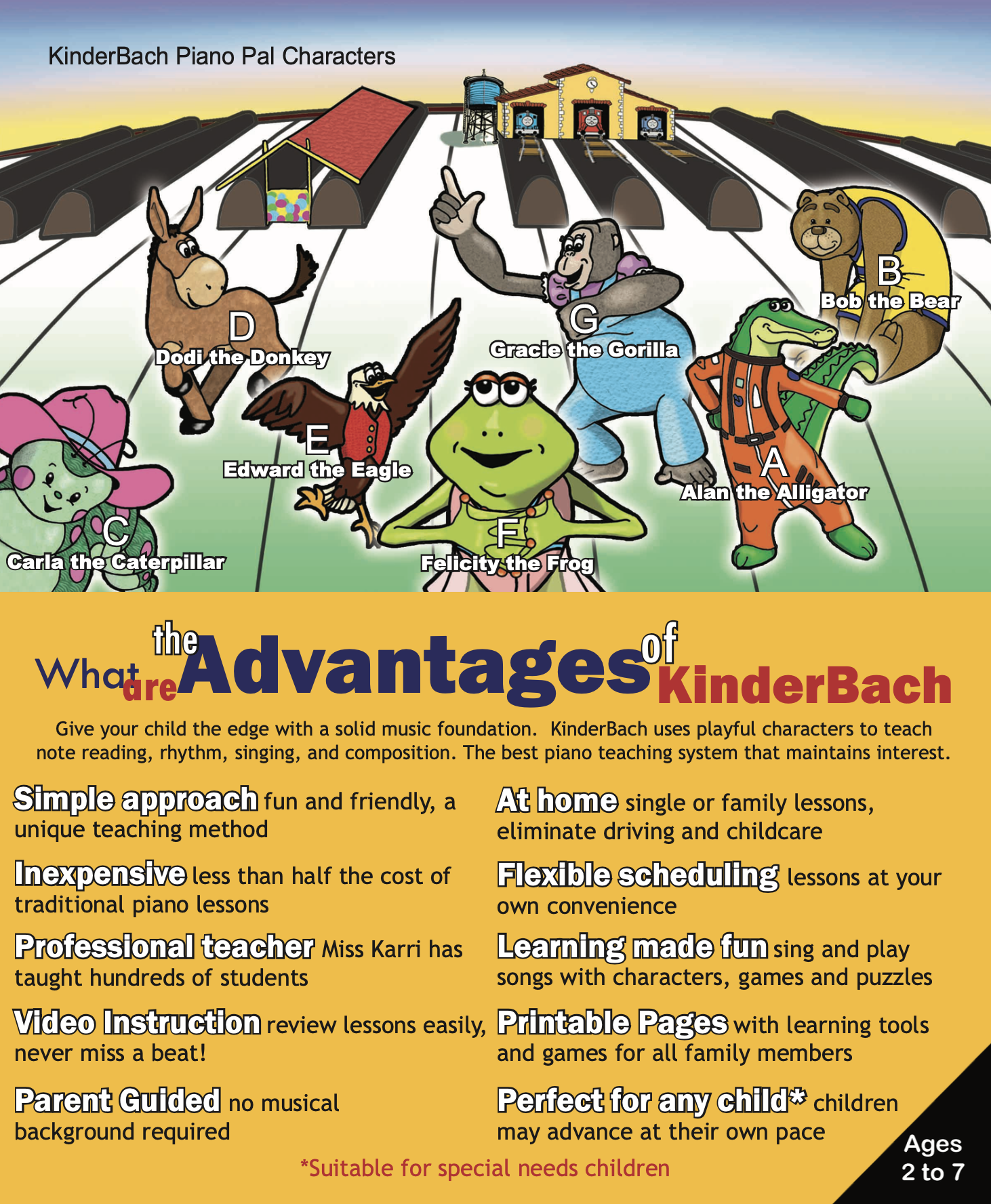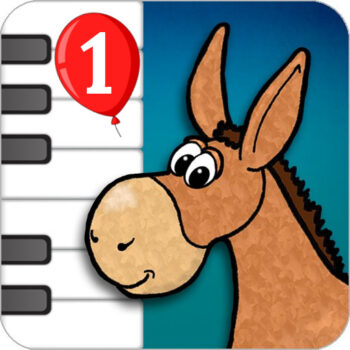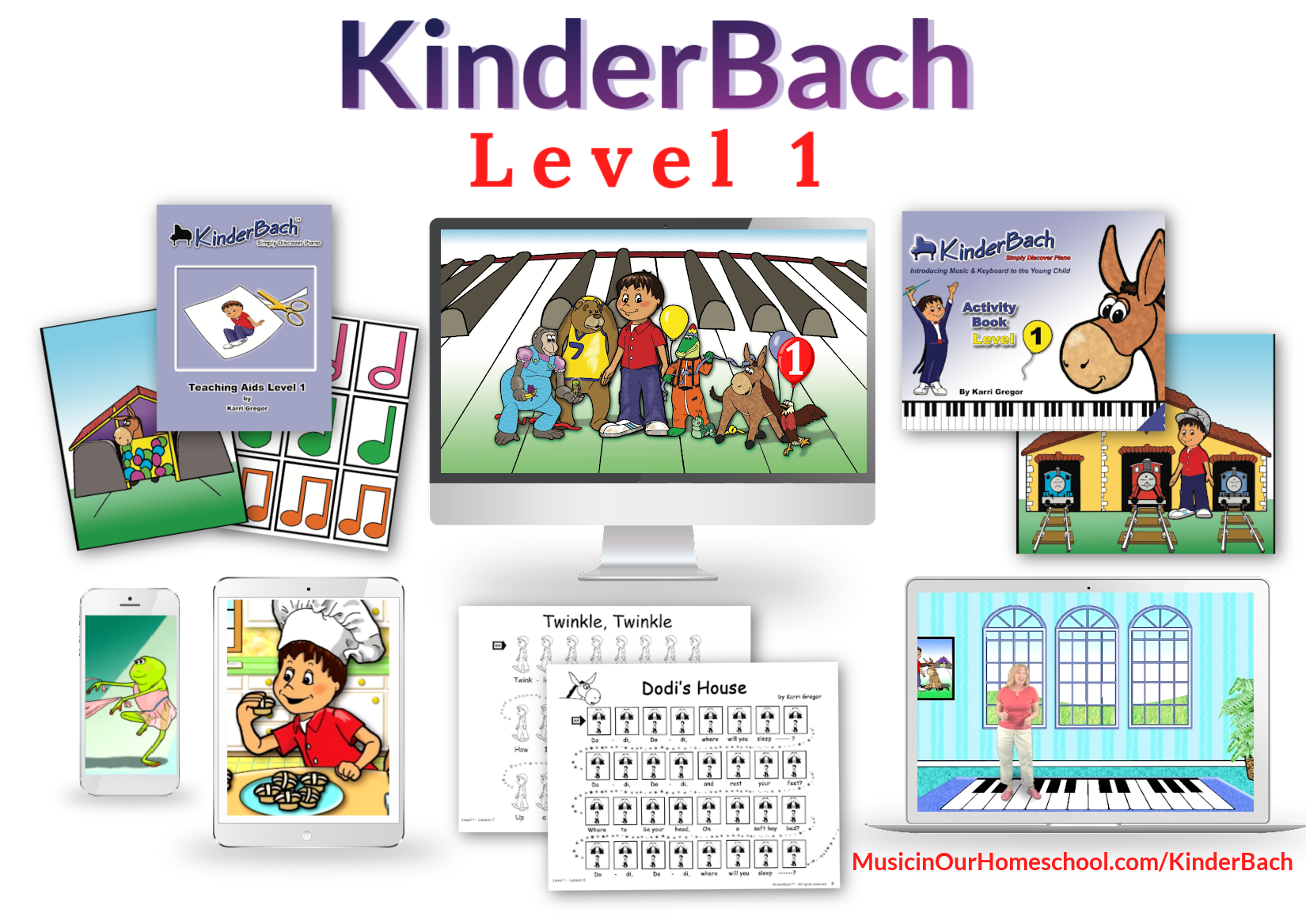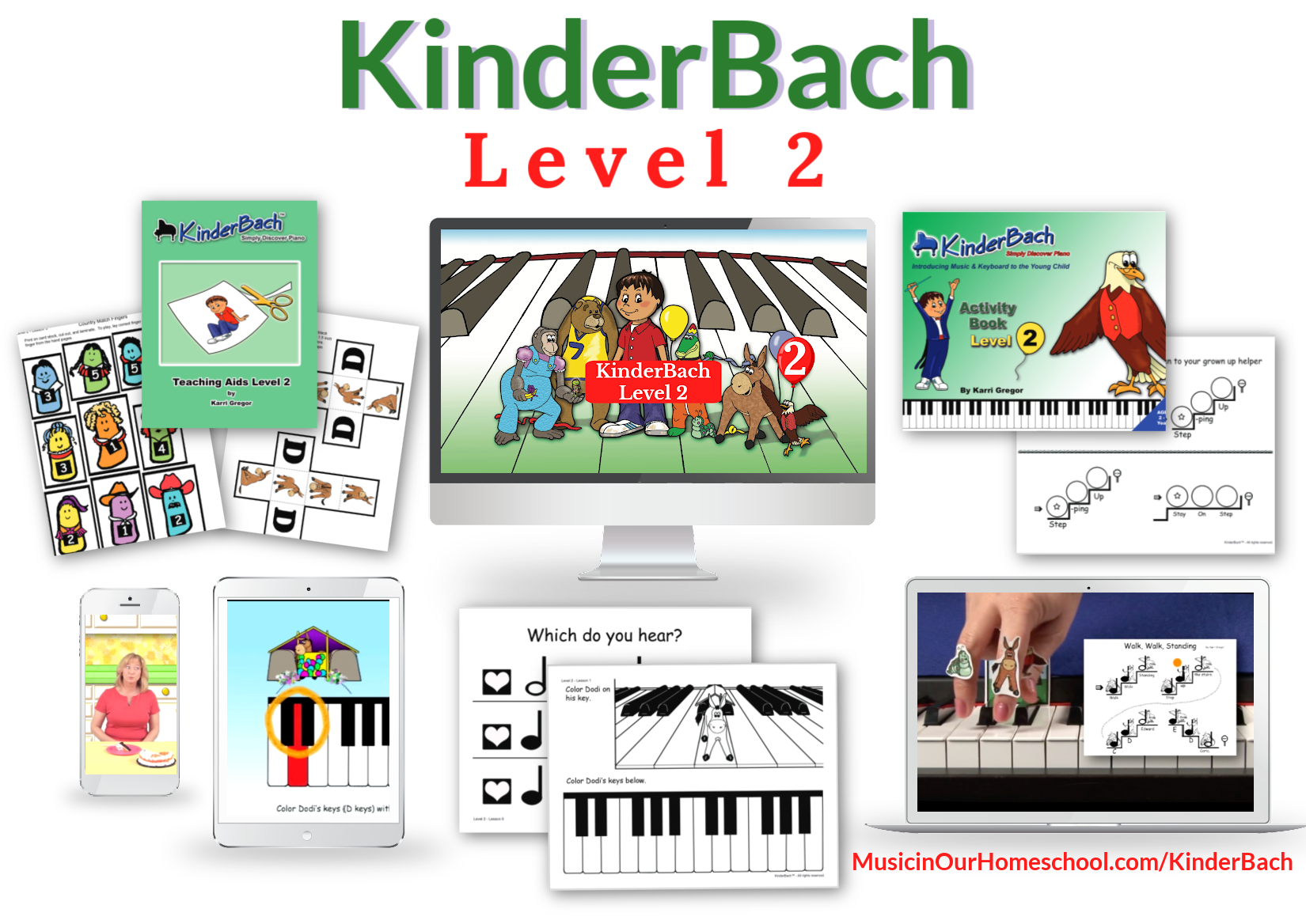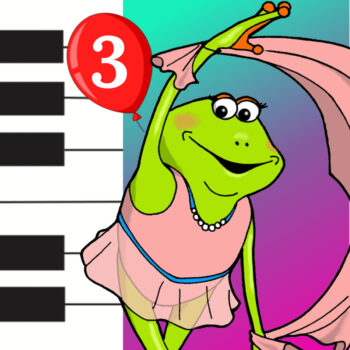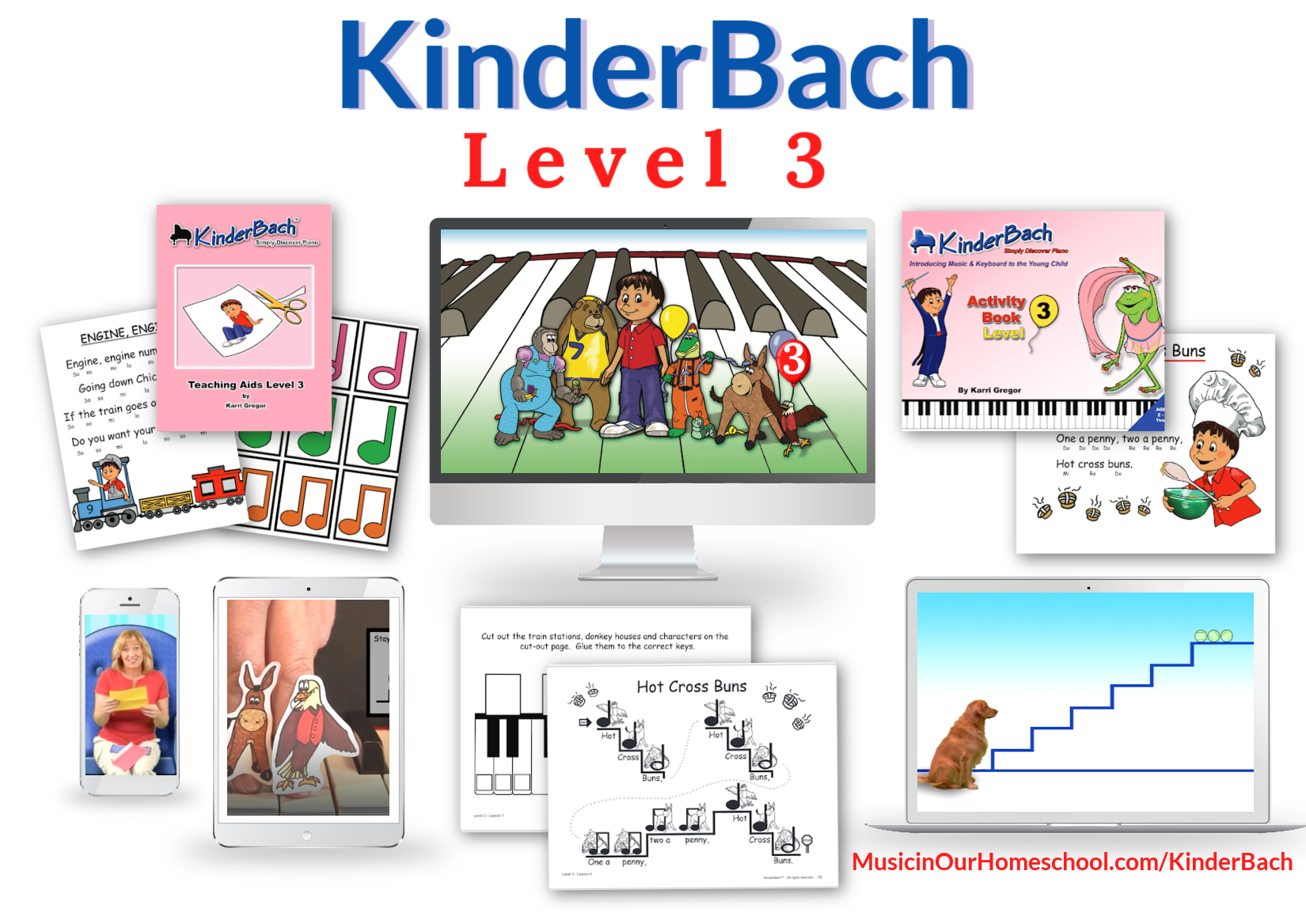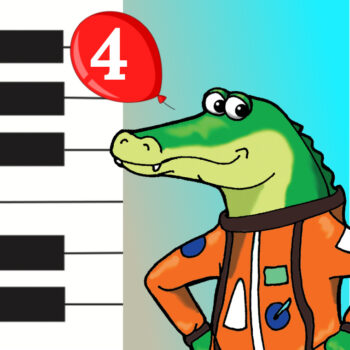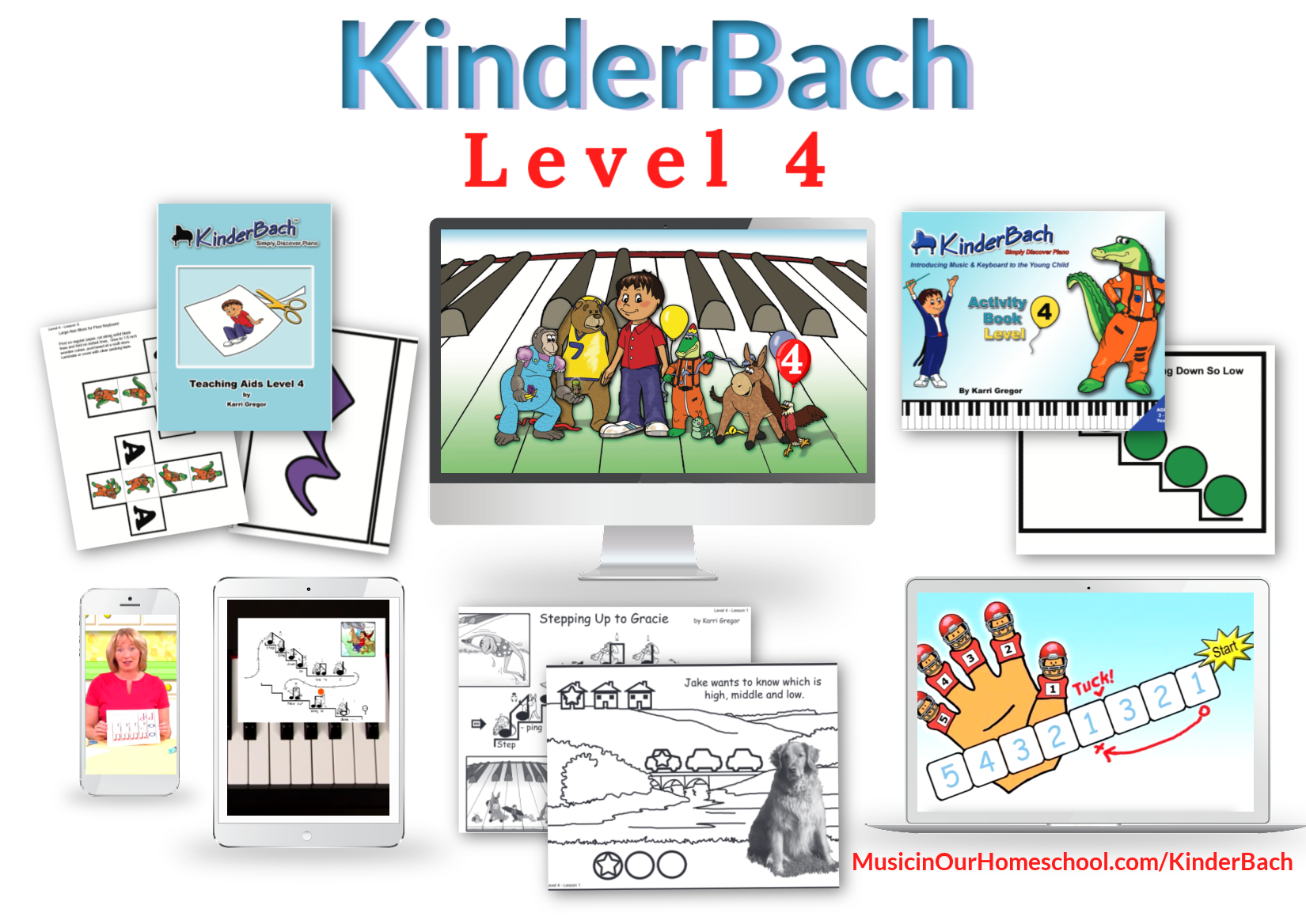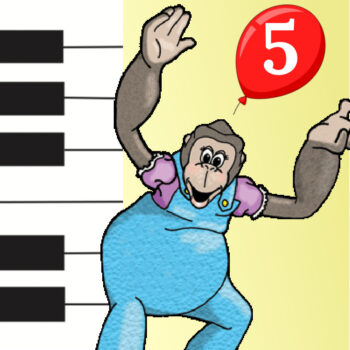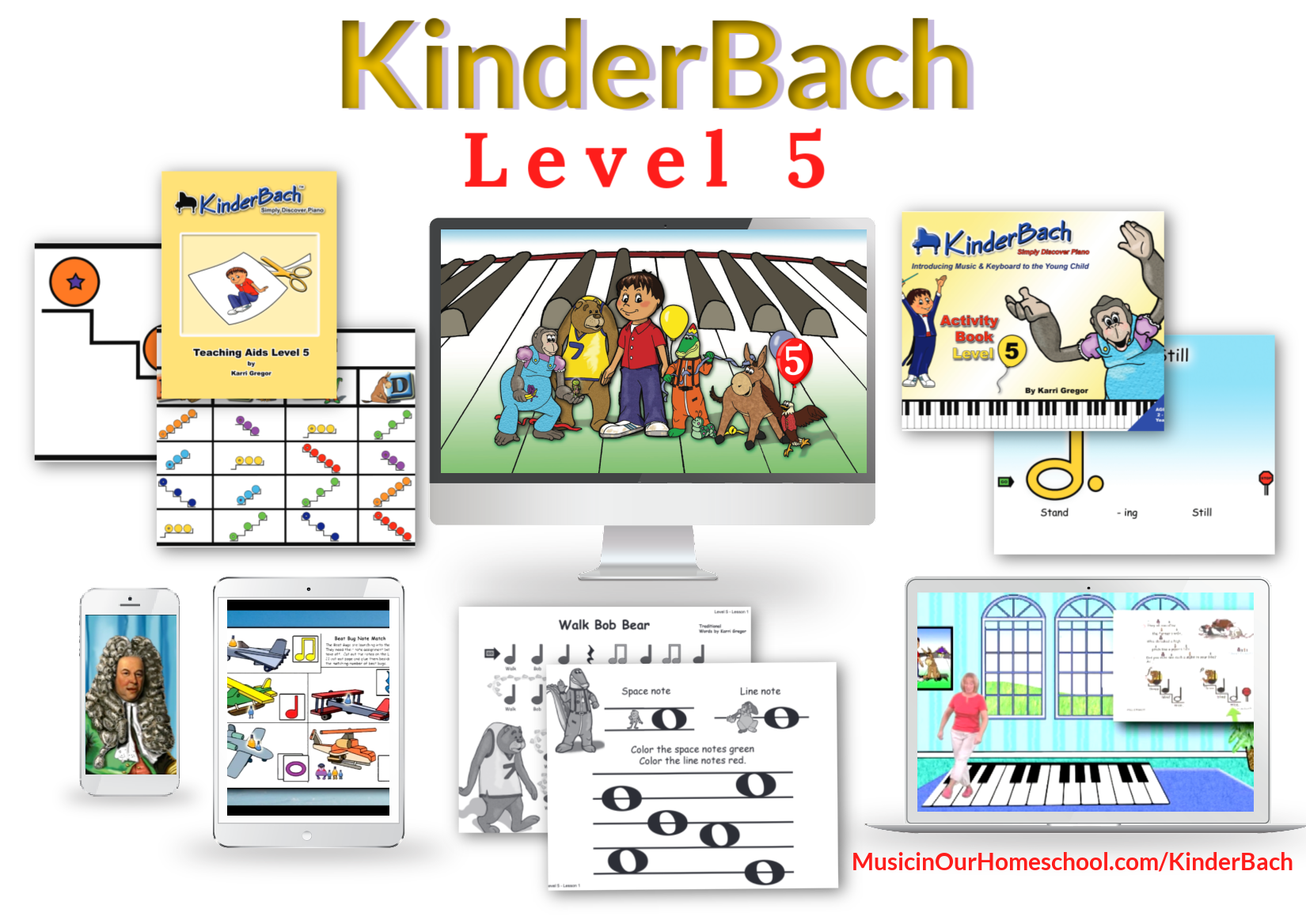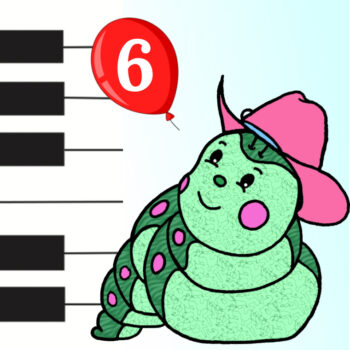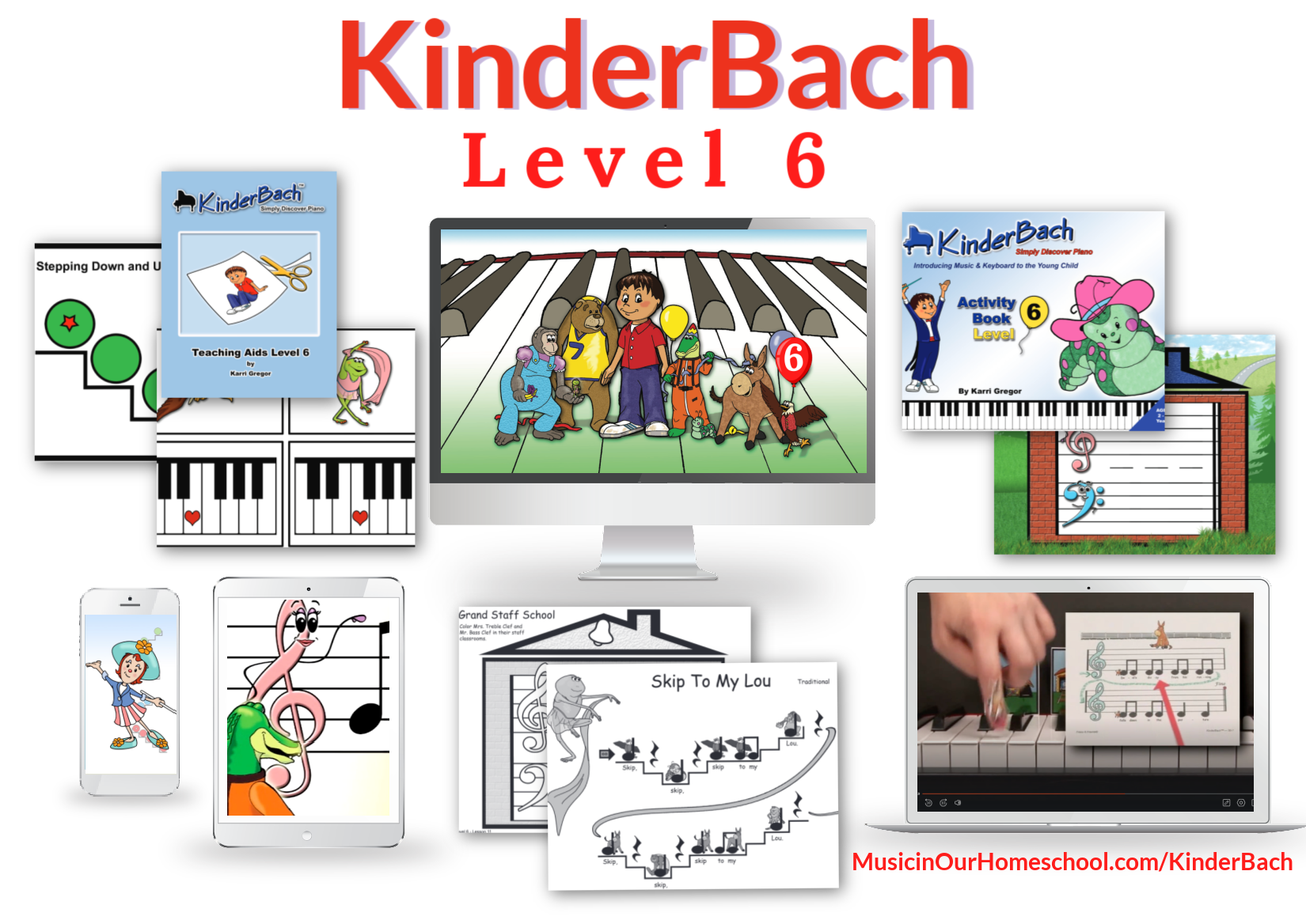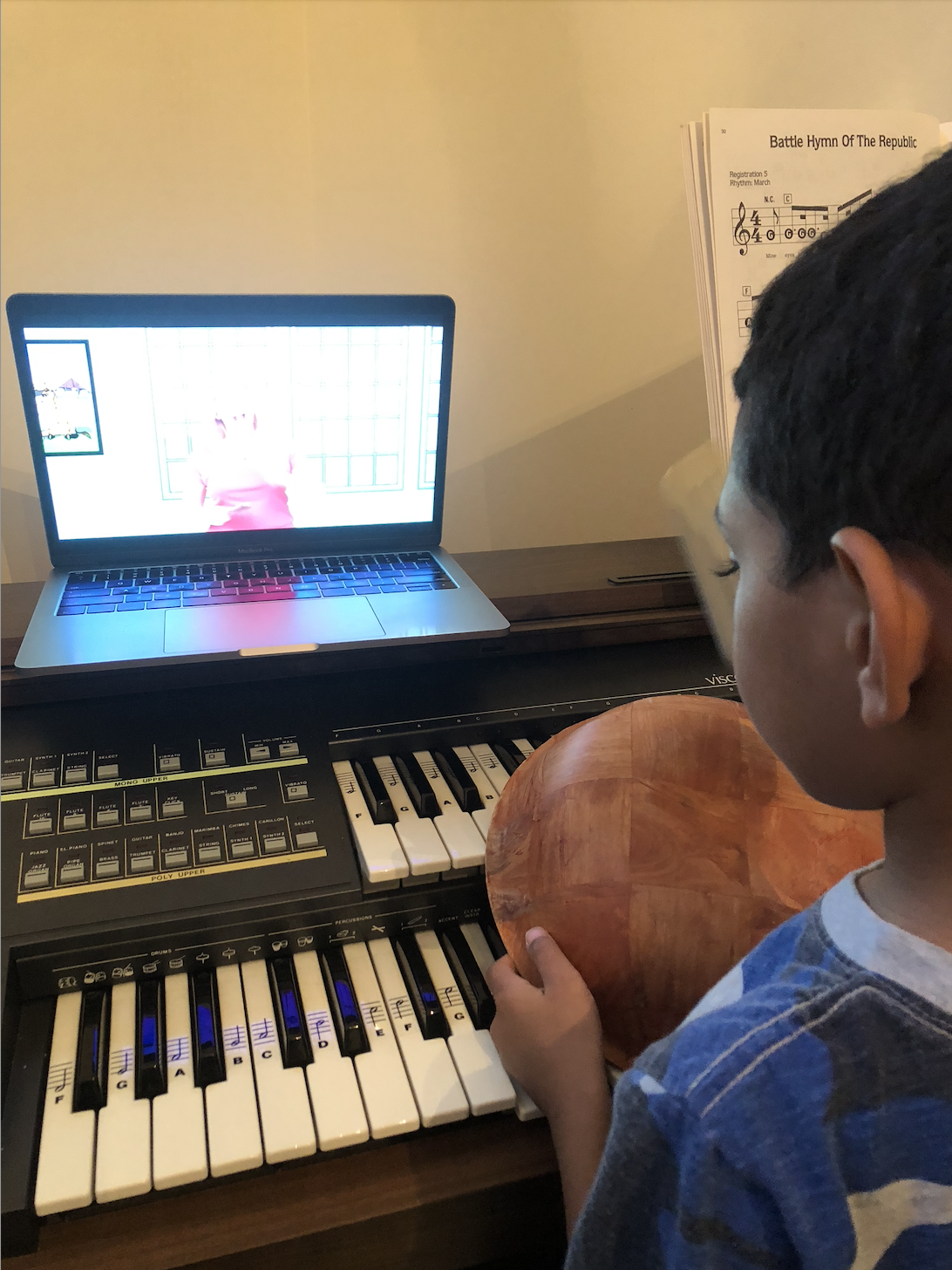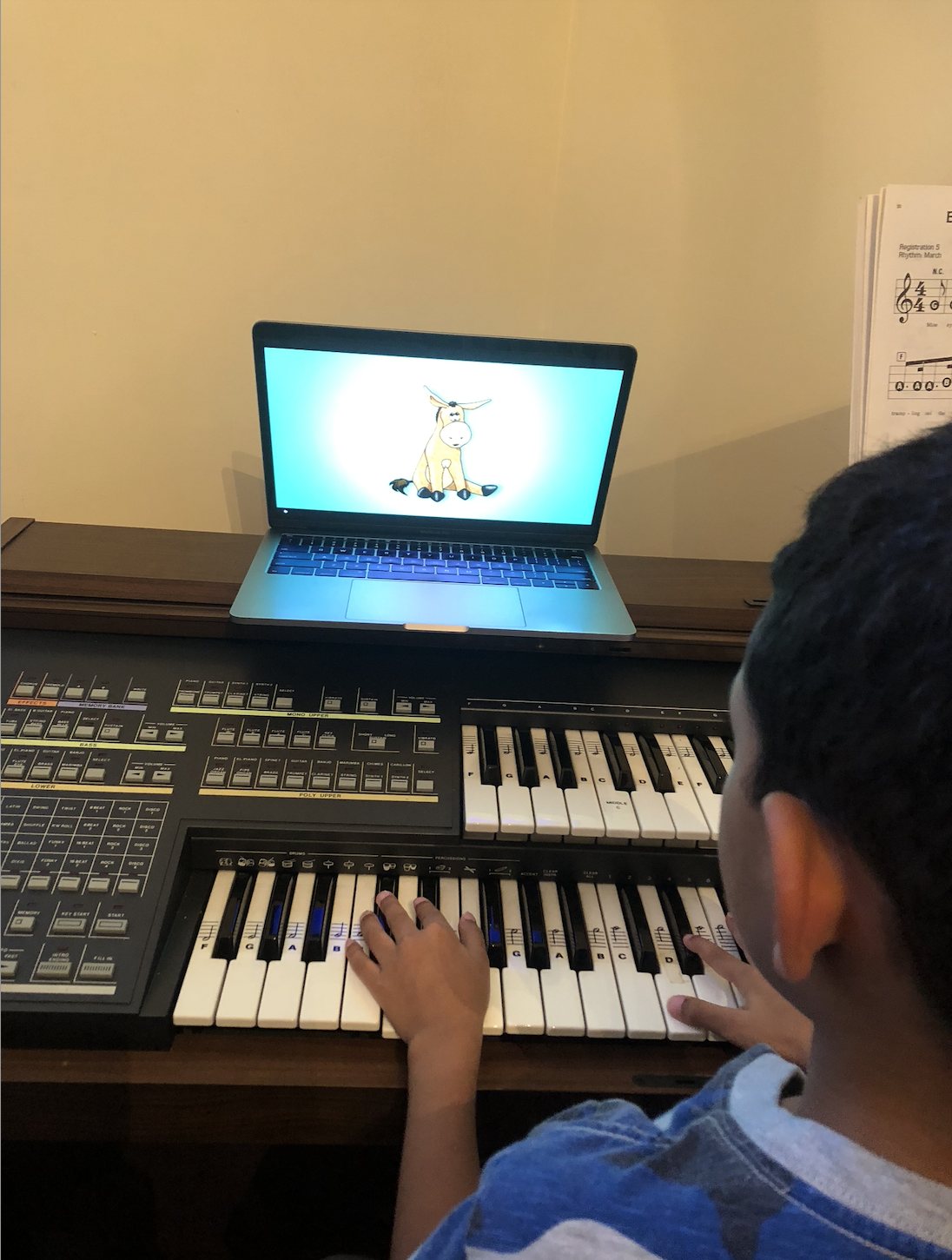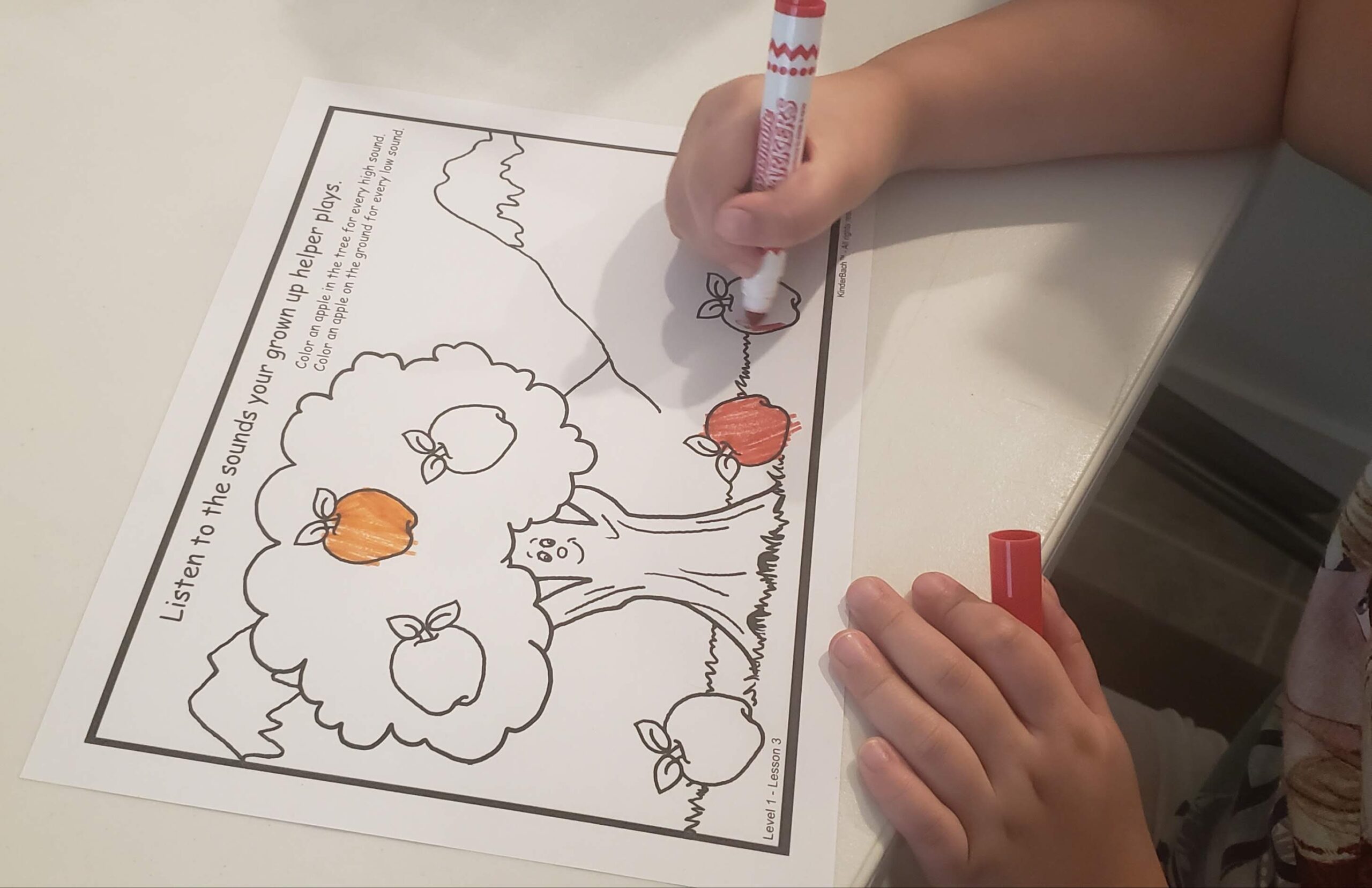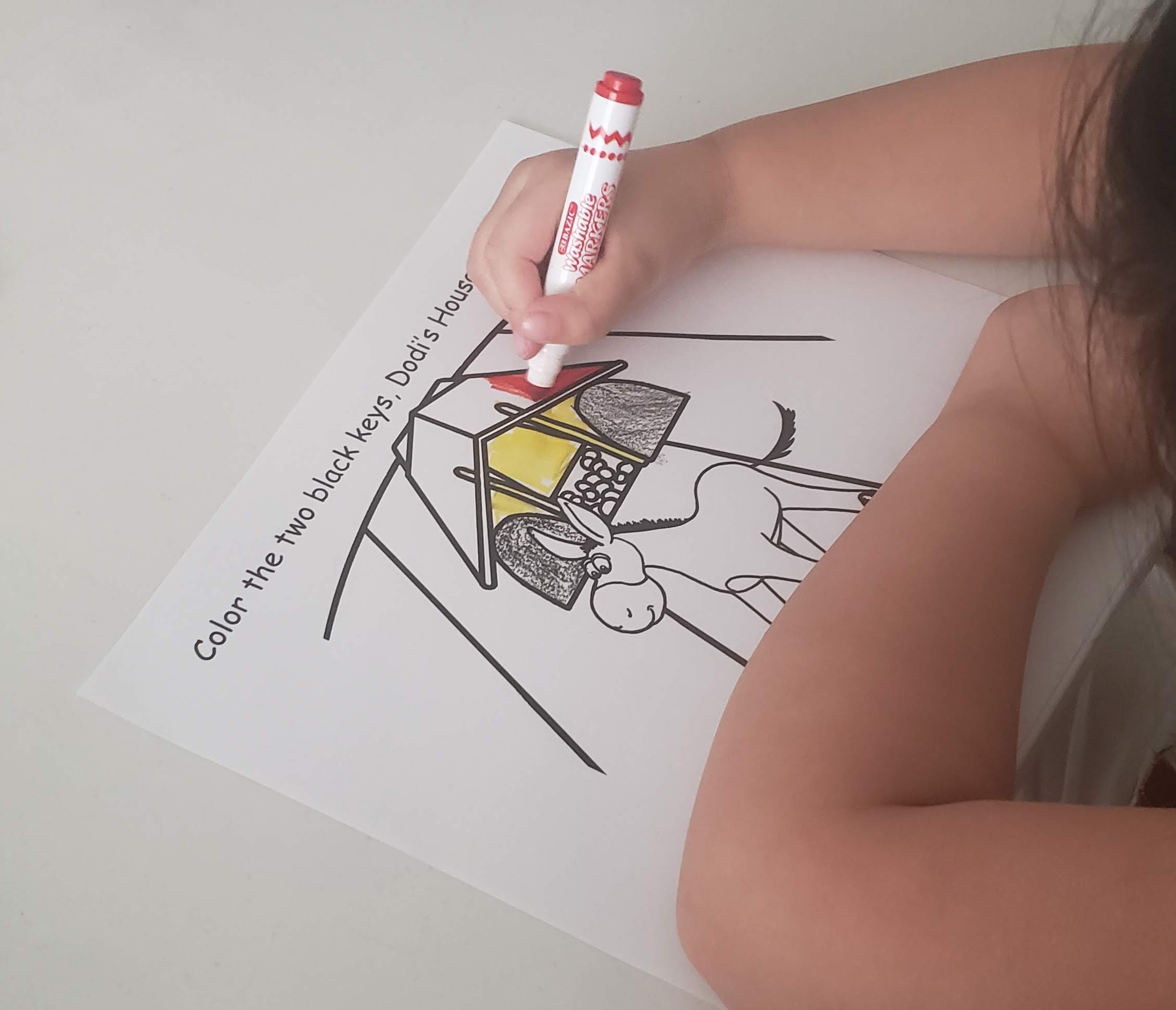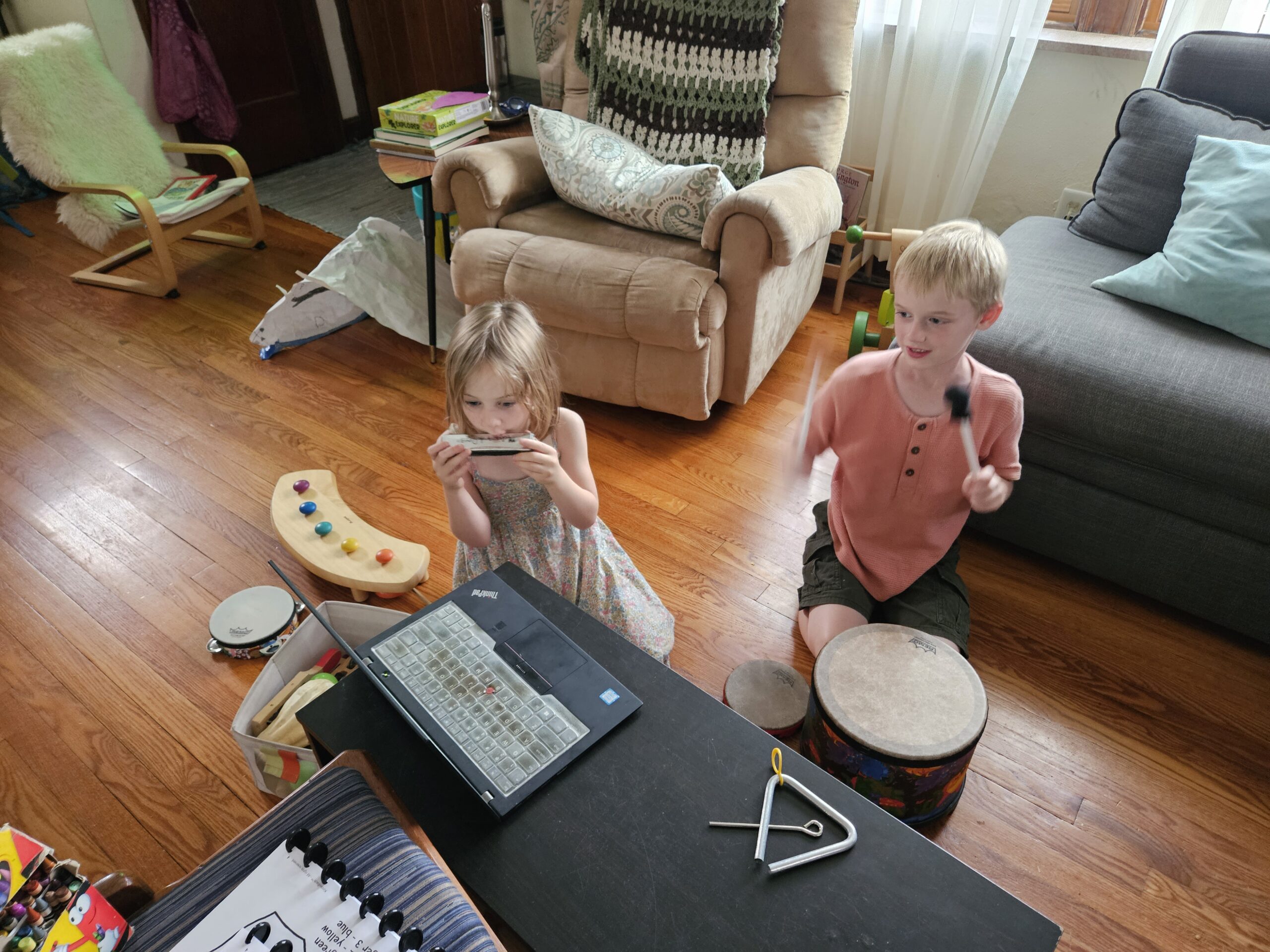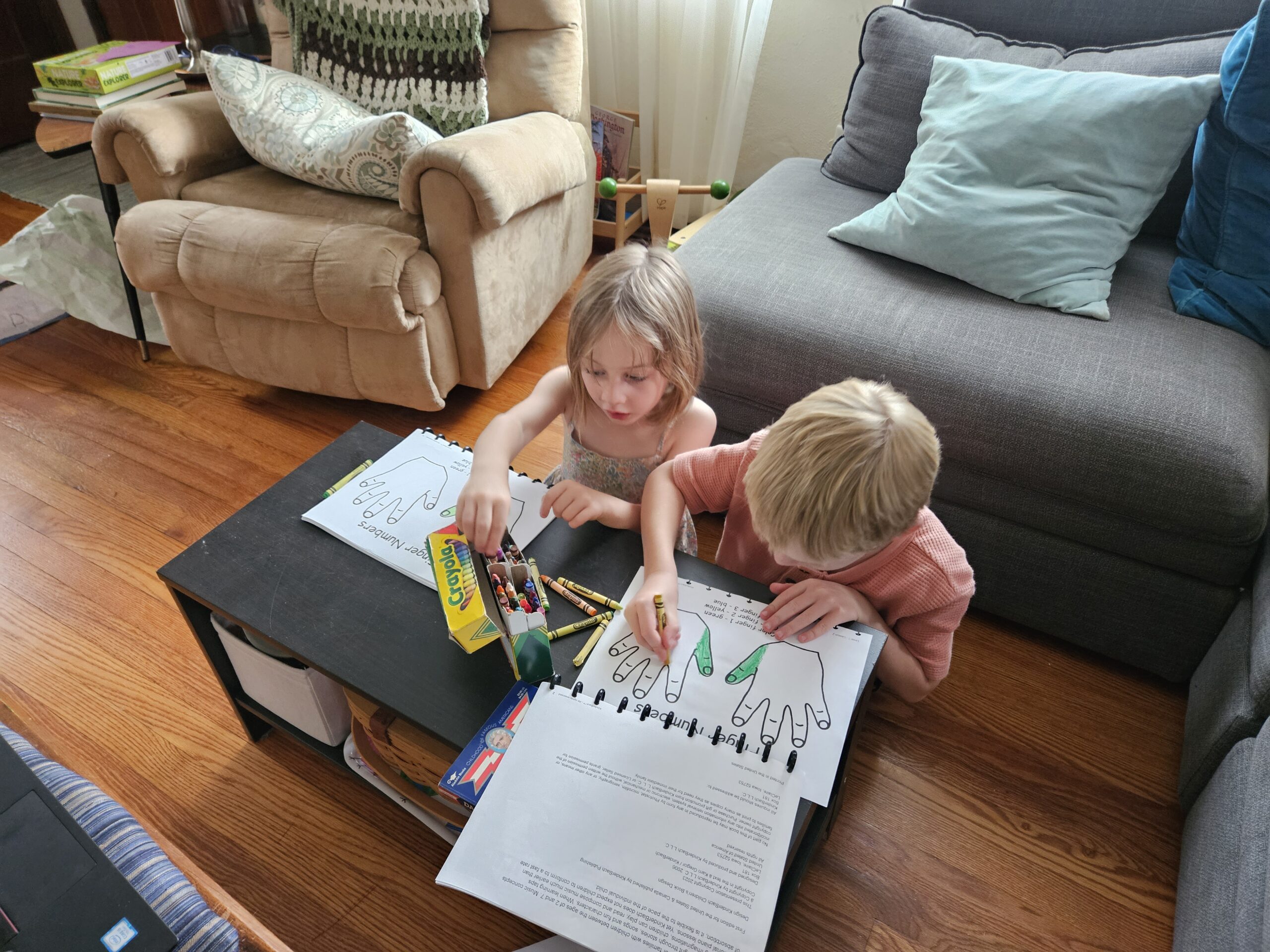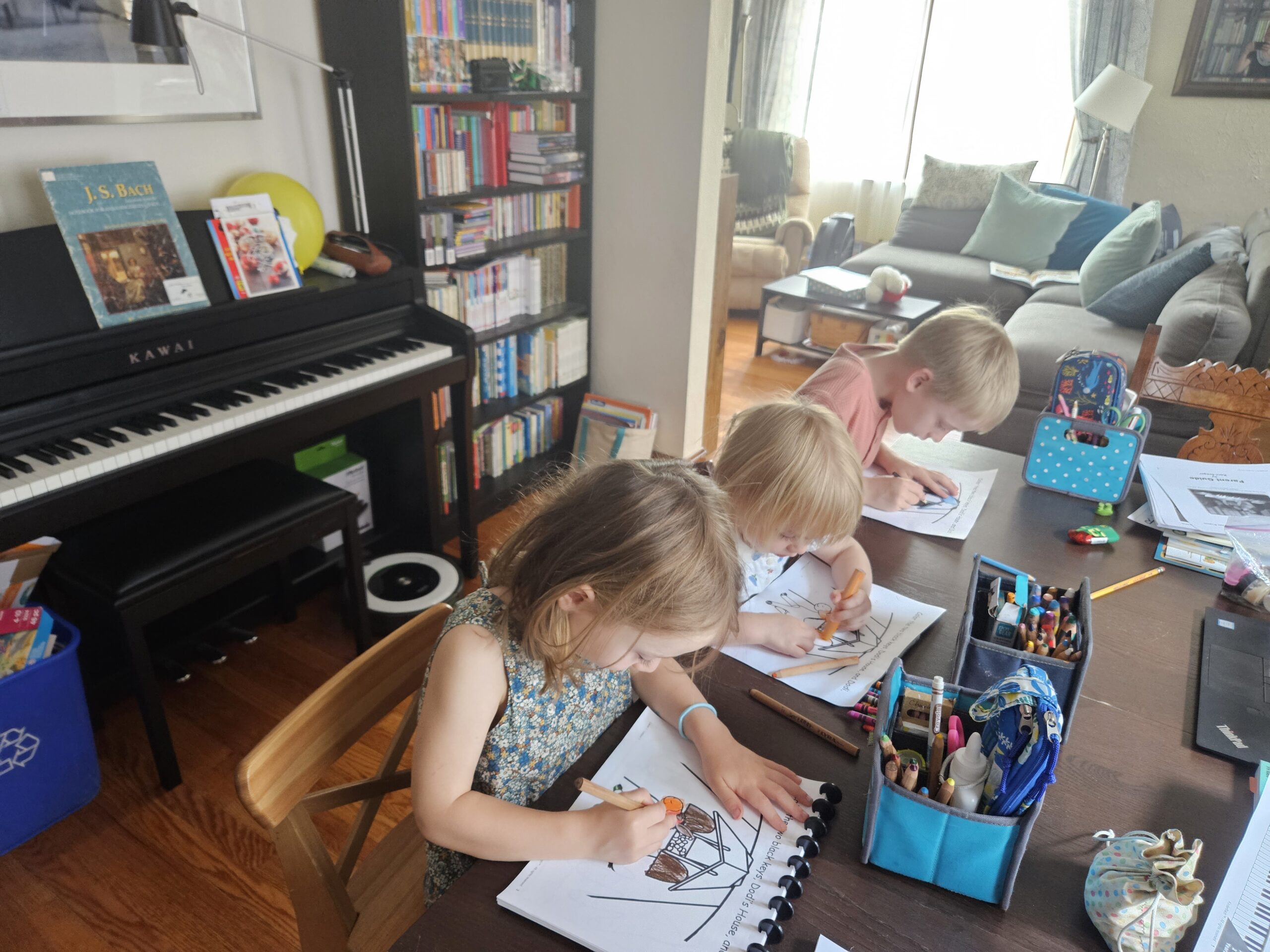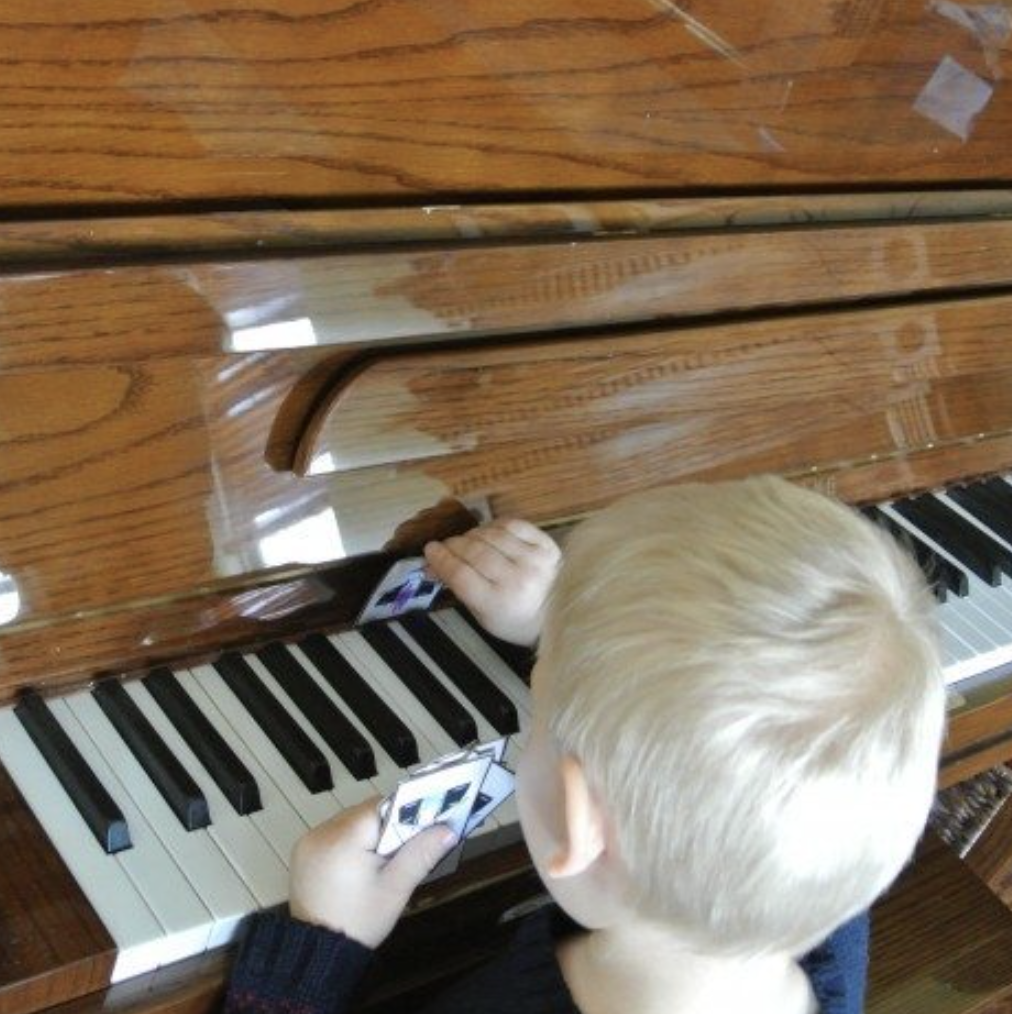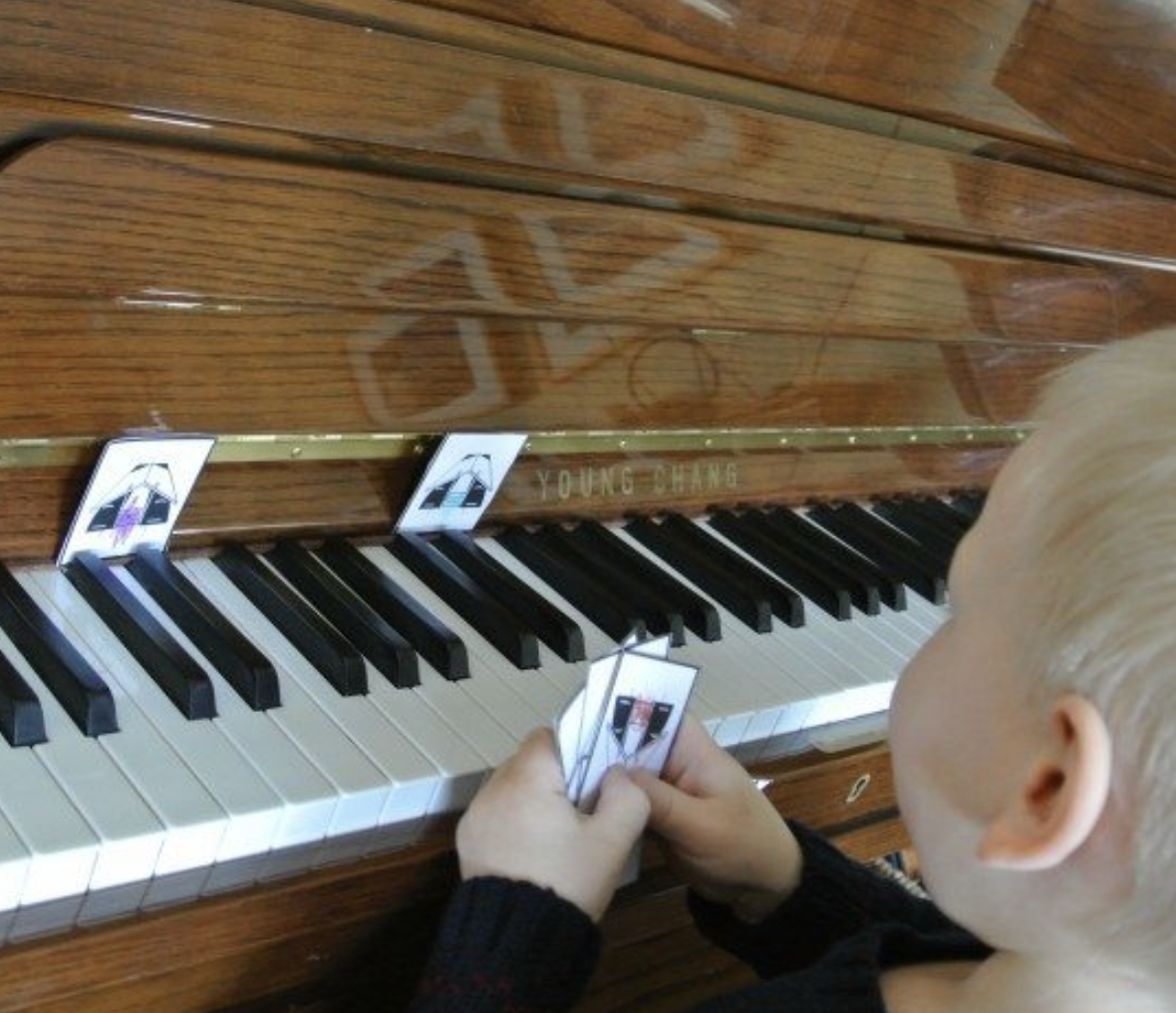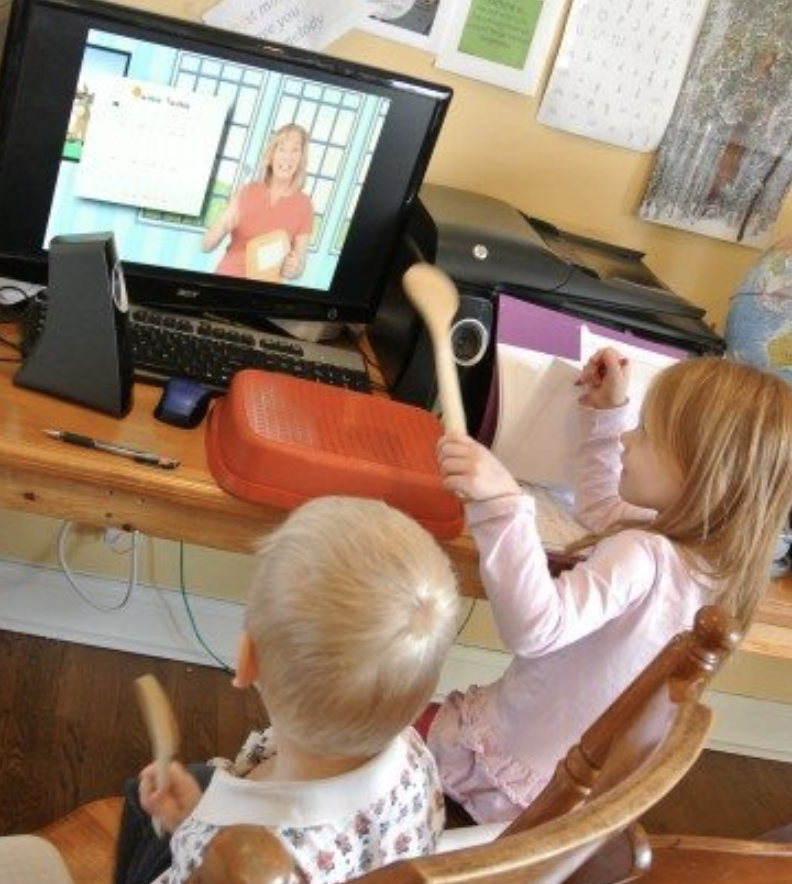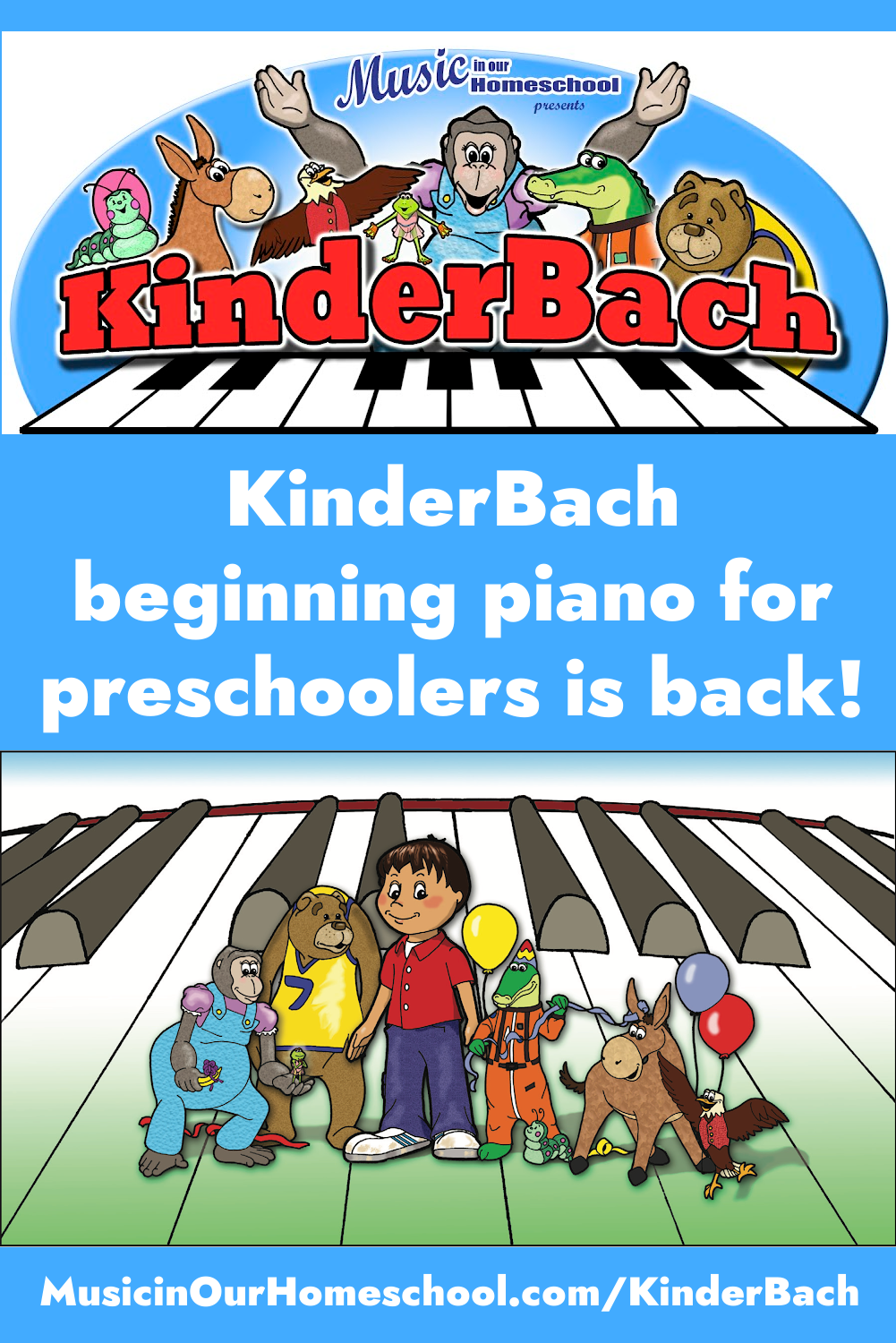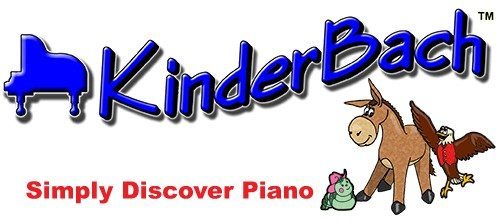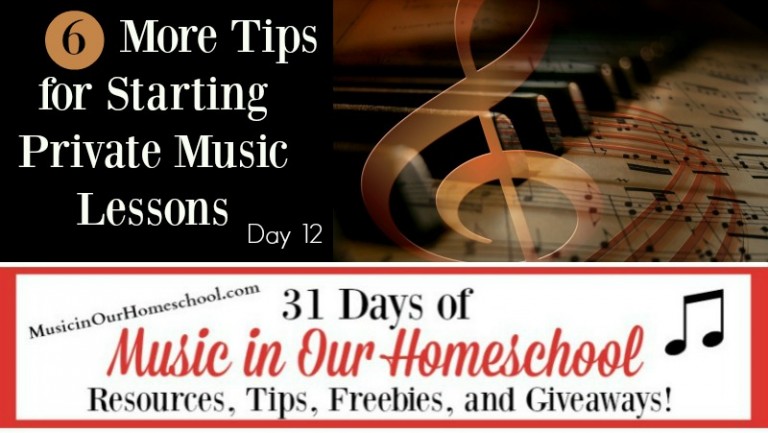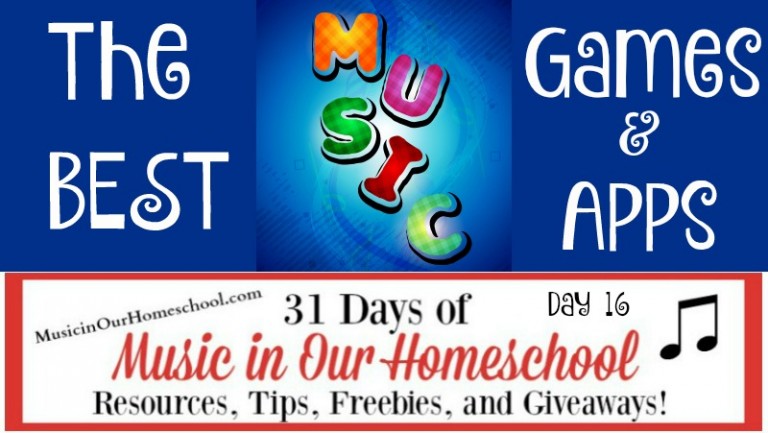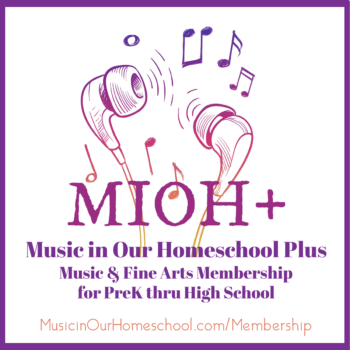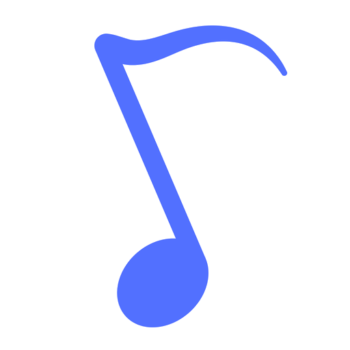Piano for Preschoolers with KinderBach
KinderBach, beginning piano for preschoolers, is back! Created by Karri Gregor and originally only offered by DVD and printed books, it’s now available as a digital course exclusively through Music in Our Homeschool!
See all KinderBach links here:
Learn more about KinderBach and see FREE lessons at each landing page above!
Interview with Karri Gregor, creator of KinderBach and Gena Mayo of Music in Our Homeschool
Replay is here:
KinderBach is now Available!
Want to Try Out Some Lessons for FREE?
What is KinderBach piano for preschoolers?
KinderBach offers a convenient method for parents to introduce their young children (ages 2-7) to piano keyboard playing. It provides all the educational materials required such as video lessons, printable pages, coloring and activity sheets, and audios, as well as instructions on how to utilize them effectively. It’s the easiest-to-use and most effective piano for preschoolers course out there!
You don’t need any formal music education as a parent! The KinderBach Parent Guide gives you a heads-up on basic music theory.
Karri’s Philosophy of Early Childhood Music Education
KinderBach students know more music theory, pattern note reading, rhythmic ear training and many other things needed for music literacy.
My piano learning philosophy is that young children understand more than they can perform physically. They can understand beat value of notes, copy rhythms, or identify differences in dynamics far better than they can play hands together.
When we start with 3-year-olds, they can barely identify that they have different fingers. Why not fill up their music knowledge while we wait for motor capacity to develop?
In KinderBach, I’m not so concerned that they can play a tune that they have memorized the fingering in both hands for and play it like a learned dance. I’m concerned that they understand what they are playing and the symbol-to-sound relationship of written music.
I want them to be able to read what they are playing and know what everything means on the page so they will eventually be able to pick up any music and be able to play it. Not, like other piano lesson programs, where they only are able to play one song because they figured out where to start and where to put their fingers. That’s my theory of early childhood music education.
The Six Areas of Musical Development
1. Ear or Listening Skills – Beginning with the range of sound from high to low and loud to quiet, recognition and duplication of melodies and rhythm, essentially for playing by ear.
2. Sight or Note Reading – Recognizing the letter names of the individual keys on the piano, reading notes on staff, patterns and direction of music, and understanding simplified chord symbols.
3. Rhythm – Understanding the beat value and rhythm of notes and their placement within different time signatures.
4. Hand Position or Technique (for playing the piano) – Understanding the piano finger numbering system, differentiating between left and right hands, and strengthening fine motor skills. Proper hand position at the piano is introduced and modeled in much the same way as penmanship in school.
5. Singing – Vocalizing music adds to the pleasure of music education. Singing is an essential building block for playing by ear.
6. Composition – Guidance in using the tools and skills learned to create music. The composition area of the KinderBach curriculum teaches the student not to simply copy or recite music, but to create it– making music a true outlet for artistic expression.
Advantages of KinderBach for Preschoolers
The Advantages of KinderBach:
- Gives your young child a solid music foundation
- Uses playful characters to teach note reading, rhythm, singing, and composition
- A piano for preschoolers system that maintains interest
- Simple approach, fun, friendly, and unique
- Inexpensive
- Professional teacher – Miss Karri has taught hundreds of students
- Video instruction – review lessons easily
- Parent guided, but no musical background needed
- At home – single or family lessons
- Eliminates the need for driving or childcare to go to a lesson
- Flexible scheduling – lessons at your own convenience
- Learning made fun – sing and play songs with characters, games, and puzzles
- Perfect for any preschool-aged child (ages 2-7, but especially ages 3-5)
- Suitable for special needs children
What do Preschoolers Learn with the KinderBach Beginning Piano Course?
- Familiarity with the black and white keyboard landscape.
- Aural discrimination of high and low sounds as well as loud and quiet.
- Music term “Piano” means quiet or soft.
- Quarter note, half note and the beat value of these symbols in common time.
- Keeping the beat with rhythm instruments and on the piano.
- Distinguishing left and right hands.
- Finger numbers for playing keyboard.
- Introduction to songs that will be used for Kodaly Solfege.
- Introduction to pre-Staff note reading by patterns.
KinderBach ~ Level 2
- Review all concepts from Level 1
- Characters for C, D, & E and their location on the keyboard.
- Emphasize relationship of the character to their letter name.
- Play simple songs with these notes.
- Aural discrimination of high, middle, and low sounds.
- Music terms “Piano” and “Forte”.
- Identify simple rhythms.
- Introduction of two Solfege terms.
- Play pre-Staff note patterns on the keyboard.
KinderBach ~ Level 3
- Review all previous concepts.
- Add characters for F & G and their location on the keyboard.
- Emphasize relationship of the character to their letter name.
- Play simple songs with these notes.
- Aural discrimination for music direction.
- Eighth notes and their beat value in common time.
- Addition to Solfege terms.
- Proper hand and finger position at the piano.
- Addition to pre-Staff note patterns and playing them on the keyboard.
- Identify pre-Staff note patterns by ear.
- Clap back simple rhythms.
- Review all concepts
- Add characters for A & B and their location on the keyboard.
- Emphasize relationship of character to their letter name.
- Play simple songs with these and other notes.
- Whole notes and the quarter rest with beat value in common time.
- Addition to dynamic terminology
- Proper hand position and fingering for the music scale.
- Addition to pre-staff note patterns, playing these patterns on the keyboard and identifying them by ear.
- Introduction of staff reading using patterns.
- Identify line and space notes.
KinderBach ~ Level 5
- Review all concepts.
- Introduce the Treble & Bass clefs together with the Grand Staff.
- Emphasize character to letter and letter to placement on keyboard.
- Introduce the dotted quarter note and its’ beat value in common time.
- Addition to dynamic music terminology.
- Fingering for the C major scale.
- Introduce time signature and measures divided by bar lines.
- Addition to the more note patterns, playing them on the keyboard and identifying them by ear.
- Learn to read these patterns on the staff.
- Introduce simple methods of composition.
- Read music on staff by pattern.
KinderBach ~ Level 6
- Review concepts from previous Levels.
- Introduce the notes ‘C’ and ‘D’ on staff.
- Emphasize all characters to notes on keyboard as well as C & D on staff.
- Introduce the half and whole rest with their beat value in common time.
- Addition to dynamic music terminology.
- Finger exercises, playing the C major scale with correct fingering.
- Play familiar songs with all notes both pre-staff and staff reading.
- Addition of note patterns both on and off the staff.
- Progress with composition methods.
- Read music on staff by pattern and by recognition of ‘C’ and ‘D’ locations.
The Instruments and Supplies Needed for KinderBach Lessons
1. Keyboard or Piano: It is not necessary to purchase an expensive piano or keyboard for your preschool child to play. If he or she continues with piano lessons after KinderBach, you will need a proper piano but, in the beginning, don’t buy something you fear might be damaged by your preschooler. All he or she needs is something that has the black and white keys, preferably the regular size of keys, not miniature keys. An electric keyboard is fine, something you can set in front of the television, computer, tablet, or phone. If you already have a piano, you don’t need to go out and buy a keyboard. Just use your tablet or phone at the piano!
2. Rhythm instruments: If you have rhythm sticks, drums, cymbals, etc. … great! If you don’t have them, plastic bowls and kitchen pots and pans work fine. Encourage your child to find musical instruments in unusual objects. It enhances their creativity.
3. Activity supplies: Crayons, glue, safety scissors, cardstock, paper for your printer, and some laminating materials (if you want to laminate).
10 Steps for Success with KinderBach piano for preschoolers
- Print the Lesson
- Gather materials – lesson pages, crayons, glue, and safety scissors.
- Set up the keyboard or piano near the TV/computer or use the app on a tablet or phone at the piano. Repeat the exercises without the video to ensure the young child understands.
- Facilitate by monitoring your child’s progress throughout the lesson. Pause or stop the video to give your child time to finish an activity or answer a question him/herself.
- You know your child. Cover only what your child is capable of understanding and accomplishing at one time. Be sensitive to when your child has had enough for one day. He/she can always come back tomorrow fresh. How much time children spend is relative to their age. Try to keep music time a happy time by not forcing it.
- Let your child watch the same lesson several times throughout the week for practice. Encourage participation, but don’t be surprised if your child just wants to observe the first couple of times. Some children absorb better this way and are more confident because they know what is expected of them. Practicing includes games, cutting, pasting, and coloring as well as playing the piano, giving the child a variety of review methods.
- Try to have a lesson or practice time with siblings or other friends. This will prevent music time from becoming the isolating, negative experience many adults remember. Music should be an experience shared, a great way to encourage teamwork and connection between players.
- Make time for music. Ideally, a lesson or concept should be reviewed a minimum of 5 times during a week. This won’t be hard for children to do. You know how they will review something they like. Work it into their routine. Even if it is just 5 or 10 minutes, they will retain more information longer because of it.
- Your child will feel more accomplished when he or she can play recognizable tunes. Four KinderBach songbooks are available: The Everyday, Christmas, Hymns, and Patriotic songbooks are designed to satisfy the eager child with easy familiar songs they can play right away with few or no lessons.
- Play songs with your child or sing while they play. Actively participate and they will learn faster and firmer.
Who is Karri Gregor, Creator of KinderBach?
Karri Gregor is a visionary music educator and the creative mind behind KinderBach, a comprehensive music education program for preschool and early elementary children. With a background in fine and studio arts and a minor in drama from the University of Saskatchewan, Karri initially conceived KinderBach as a story book series before transforming it into an engaging music curriculum. Recognizing the importance of storytelling in children’s understanding, Karri developed the Piano Pals, a delightful group of characters who reside on the keyboard landscape.
Karri’s dedication to making music accessible and enjoyable for children empowers even the youngest learners to experience success at the keyboard. With a passion for providing children with a solid music foundation, Karri’s expertise and innovative approach have impacted countless young musicians and families worldwide.
What Homeschool Moms Like You Say About KinderBach!
My daughter absolutely loves KinderBach! The videos make it so fun and easy for her to learn piano at home, and I love that she is also learning important music skills that will help her be able to read music as well. This program is a perfect positive first experience for kids who are just getting started playing the piano. I would definitely recommend this program for parents who want their kids to learn piano at home!My daughter just came in and said “Can we do that fun music thing again?”~Sarah Miller of Homeschooling 4 Him
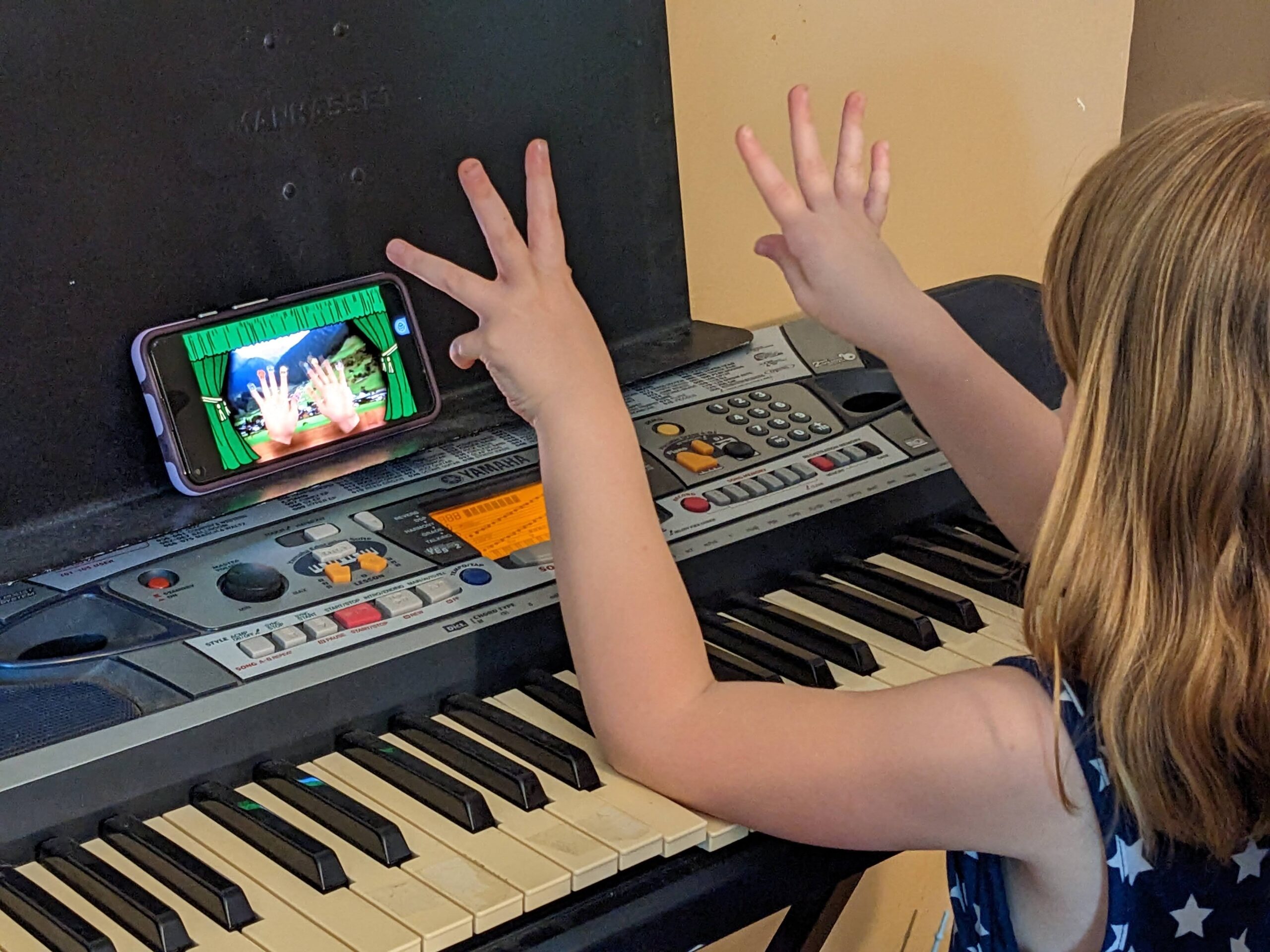
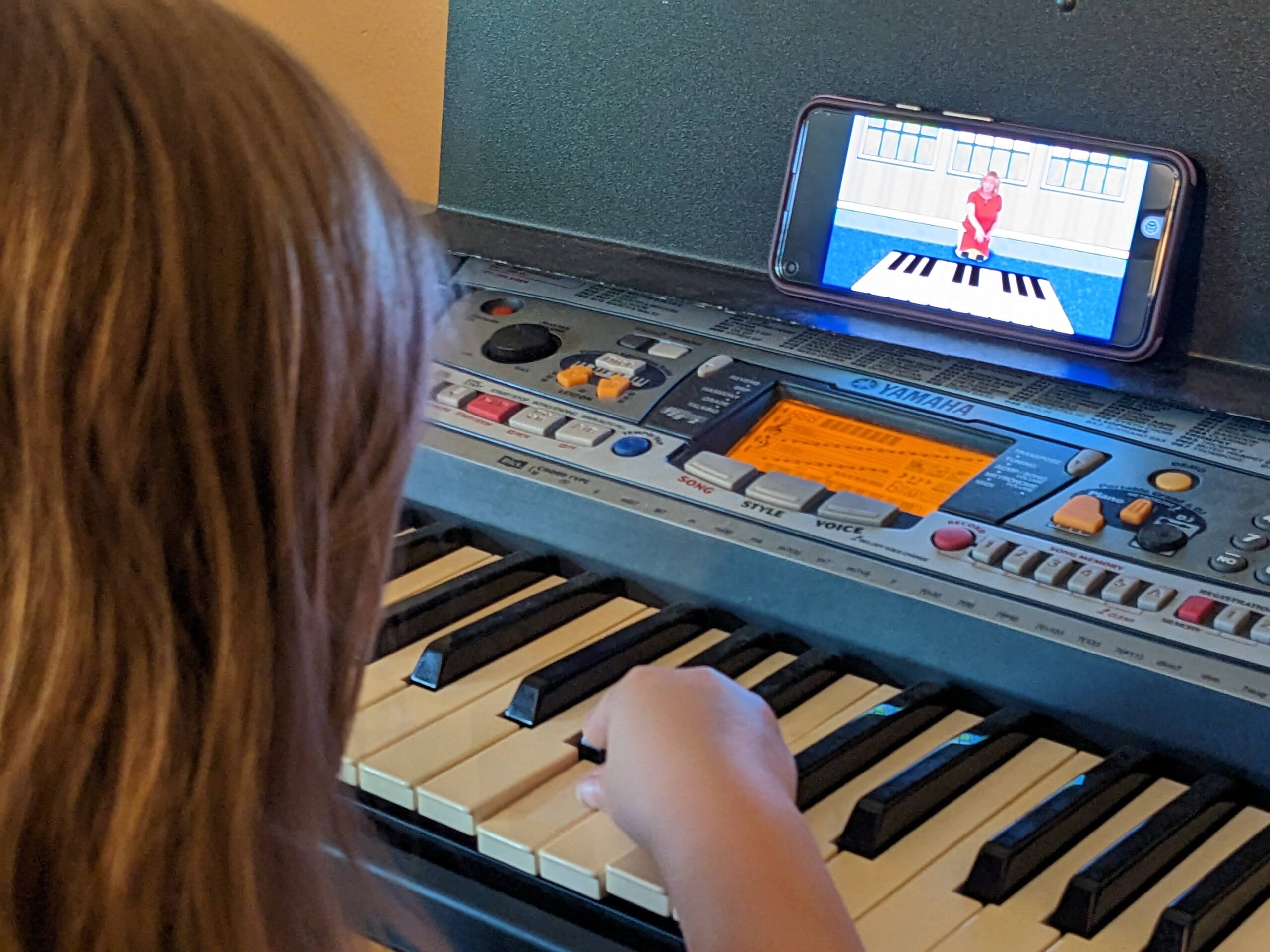
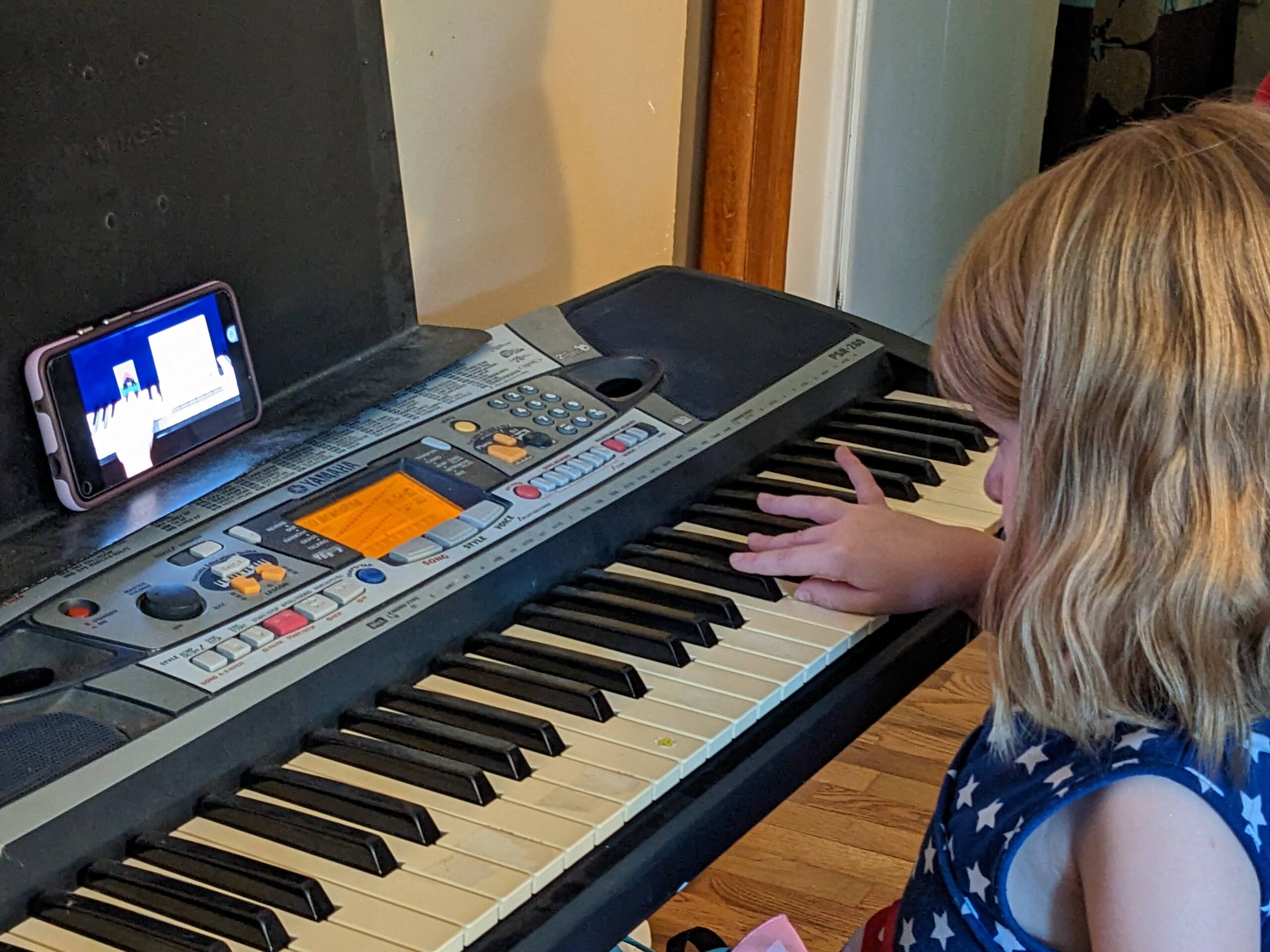
As a musically minded mom and homeschooler, KinderBach is SO cute! I love the hands on learning and application and my Kindergartener loves the cute characters that go along with it. If you want your preschooler thru 1st grader to learn piano, I highly recommend this as a great place to start.~Kimberly Steenbergen of A Family Devoted
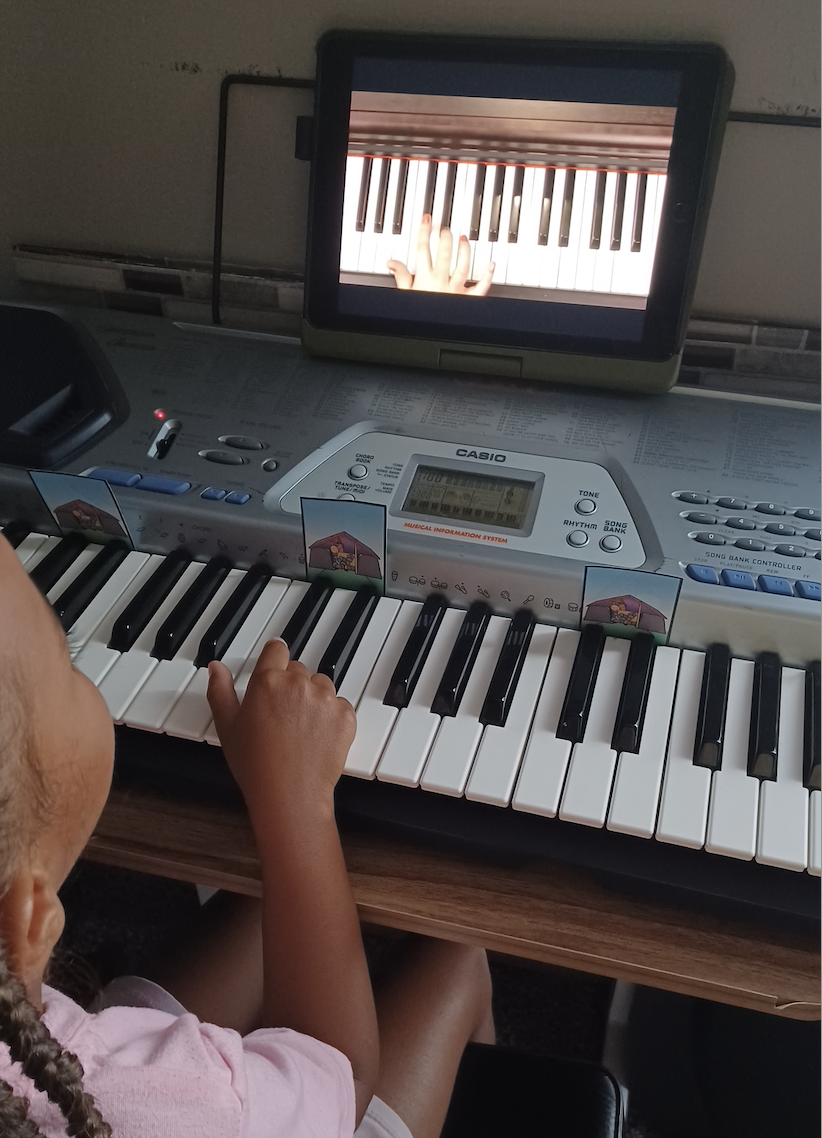
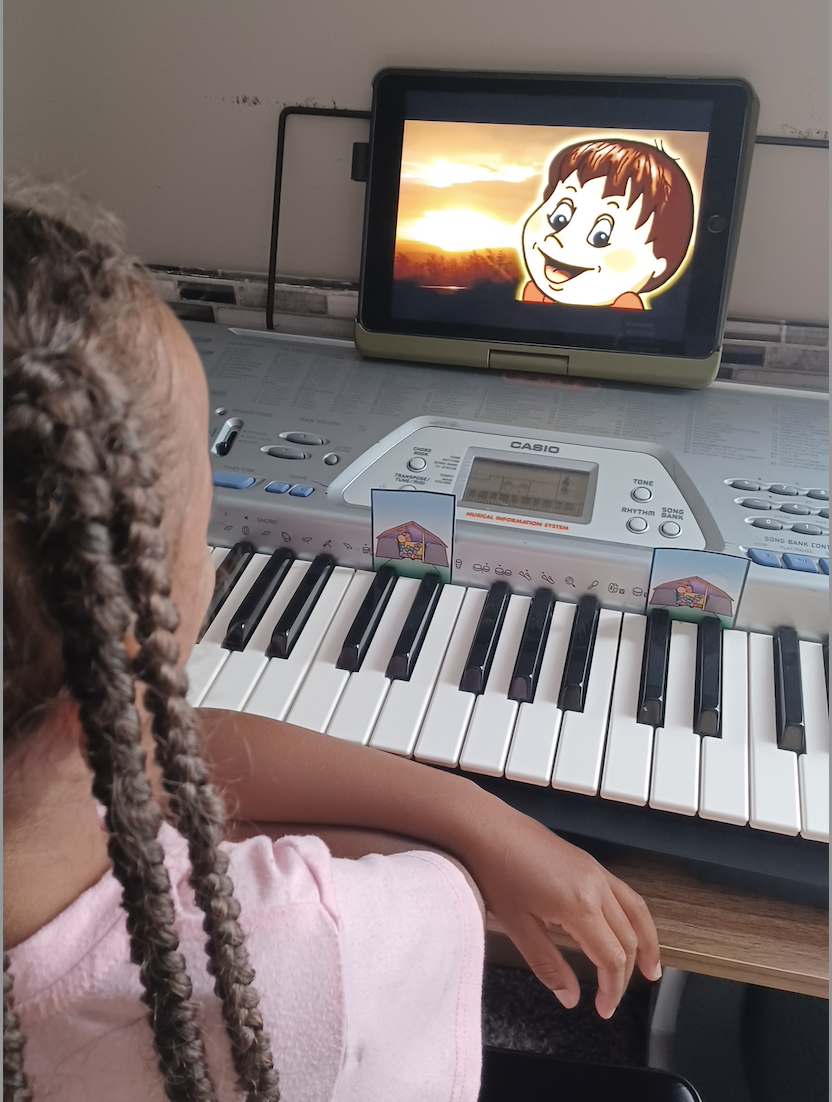
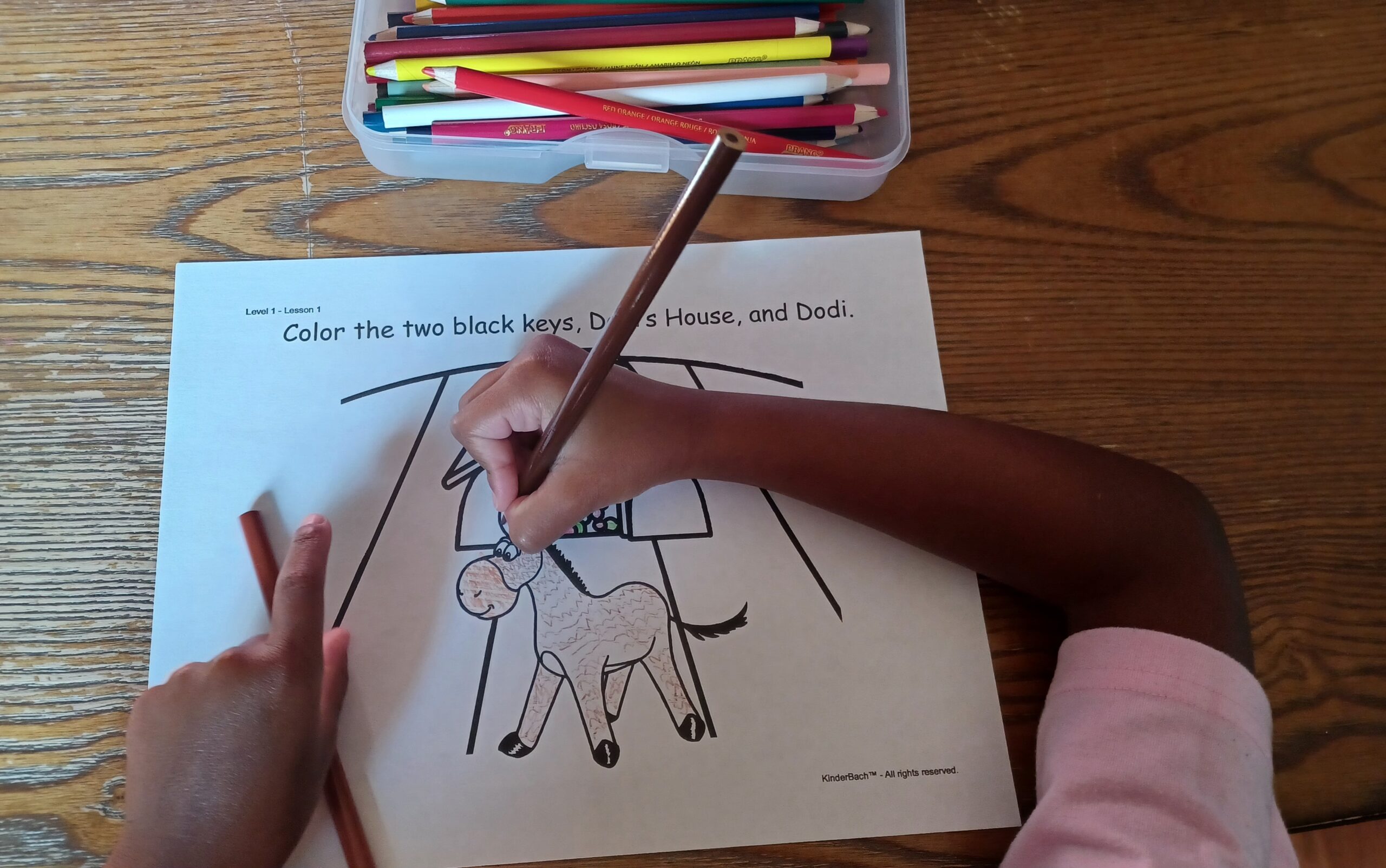
My son has been eager to learn piano, so I decided to try out Kinderbach, and it has been a fantastic choice! I love the way the lessons are structured and how easy it is for me to follow along and gather the necessary supplies. It makes each lesson a breeze, and I appreciate the convenience it brings. According to my son, the highlight of the lessons was getting to play the piano keys, the rhythm instrument, and engaging in the hands-on activities. The ability to customize the program to suit my child’s specific needs is another aspect I truly appreciate. Thanks to Kinderbach, learning piano has become a joyous and personalized experience for my son!~Jessica Anderson of Intentional Life
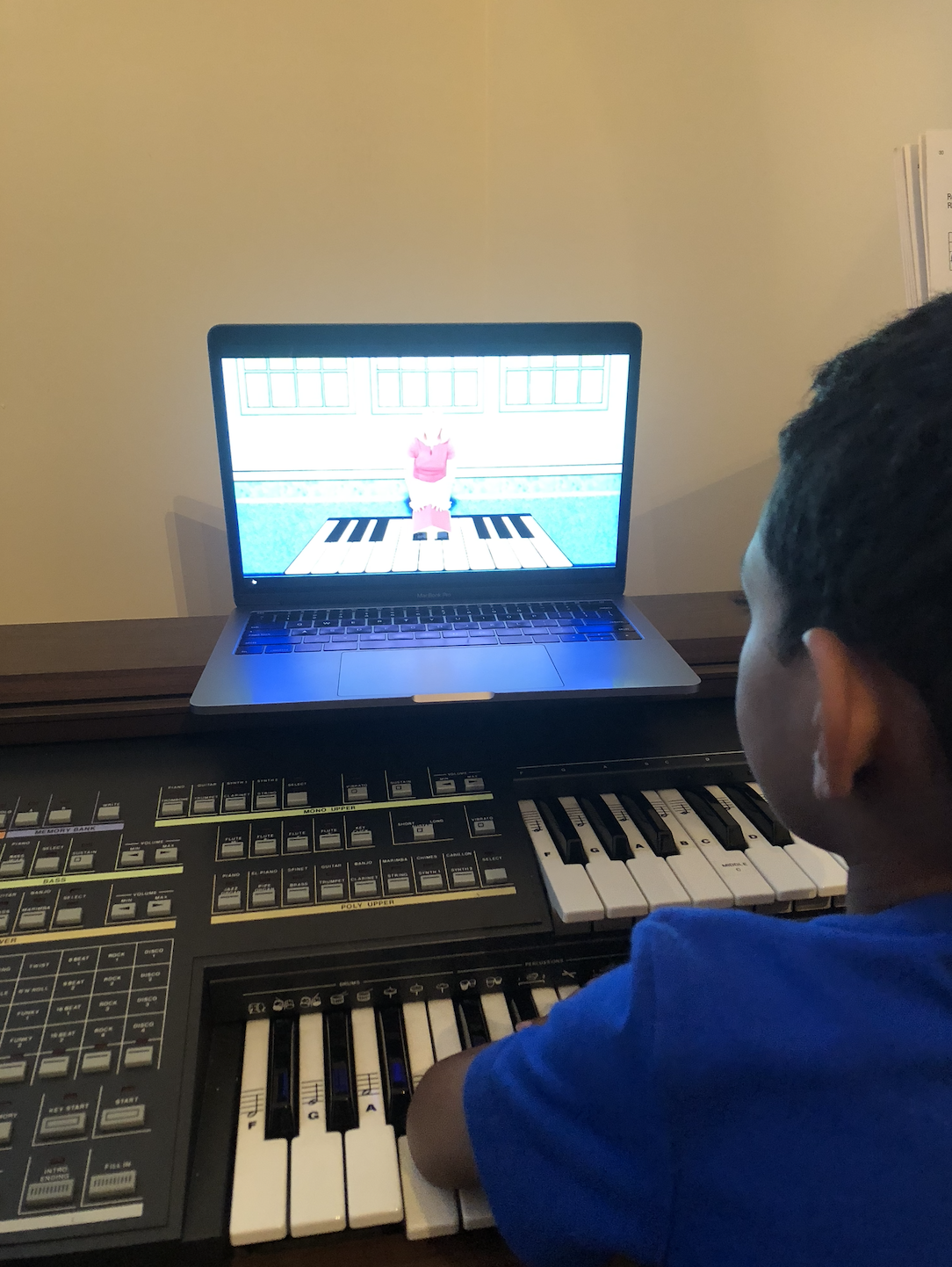
Kinderbach is such a great way to introduce music and music theory to children at the Kindergarten level or younger. My 2 & 4 year old enjoyed it immensely and could follow and answer the questions being asked. They liked Dodi and started learning about the keys of a piano which they followed well. I cannot wait to see them develop and like piano and music overall. I like how everything is laid out for me to teach them, almost effortlessly. I like doing the lessons with them too; it almost looks like I know what I’m doing and having so much fun while doing it. Thank you KinderBach!~Filipina R.
As a homeschooling mother with three young children, I have been looking for a method to teach them piano. Some local teachers have a starting age of 7+, which prevents my 4 year old who shows the strongest interest from beginning lessons. KinderBach has been outstanding at allowing my to introduce my 7, 4, and 2.5 year old to piano in a way they could understand and enjoy. And best of all, there is almost no prep time for me, other than printing off the workbook for each child when beginning a level. At lesson time, the children can learn together, with short lessons that reinforce learning without dragging on. Overall, I’m very impressed with this piano course!~Abigail M.
My Own Personal Review of KinderBach: Piano for Preschoolers
Years ago when these two cuties were preschoolers, I did KinderBach Level 1 with them and loved it! This is why I sought out Karri Gregor to bring KinderBach back!
Here is my personal review of KinderBach from back then:
My children found KinderBach piano for preschoolers very engaging. We rarely did only one lesson at a time–they wanted to keep on going and going! And often they wanted to repeat a previous lesson from the time before. Miss Karri, who teaches the lessons, really connects to the kids well. She is fun and funny.
There is also a wide variety between the lessons. One lesson might have a song for them to listen to (with photos or graphics to watch), the next could have them play along with a rhythm instrument or the piano, the next a coloring sheet to go along with a new musical concept, the next a game to learn a new concept, and the next might be a cut-and-paste activity. I printed out the PDF file of the Level 1 activities and put them in a notebook for each child.
For the mom (homeschool teacher) who will be facilitating the lessons:
All the lessons are found online, so you just need a computer with sound to watch them. Each week’s lessons begin with a short introduction, where the teacher tells you what to expect to learn that week and what materials will be needed (usually a piano or keyboard, crayons, scissors, glue, and a rhythm instrument.) You don’t have to worry about having any special rhythm instruments. She often uses things she finds in the kitchen such as a cereal bowl and a spoon!
You also don’t need to know anything about music or how to play the piano to help your kids with this program. You’ll learn everything along with them! The lessons are only about 5-10 minutes each, so don’t worry about being overwhelmed with another curriculum. You can do as much or as little as you can at each teaching session.
My unique perspective as a fellow early childhood music teacher:
I could see what the teacher Miss Karri was trying to teach to the kids–which are some of the hurdles for early music learners. I’m glad she decided to tackle these really early on since they are so basic. The concepts are
- recognizing the pattern of the piano keyboard (2 black keys vs. 3 black keys)
- steady beat
- knowing the finger numbers (labeling your fingers 1-5)
- quarter notes vs. half notes
- that half notes have 2 beats, but only one note plays for it
- strong and weak beats
- high and low pitches
- stepping up notes vs. staying the same
One of the greatest things about the program is that she uses really fun ways to get these concepts into the young kids’ hands, ears, and minds. There is a cute donkey named Dodi who lives at the 2 black keys of the piano. The Train Station is where the 3 black keys are. A boy named Frisco represents “walk” which is the way the kids learn about quarter notes. And the Beat Bugs are lots of fun for helping kids understand strong and weak beats.
The only complaint we had was that my daughter wanted to actually play the piano even more.
Gena’s son and daughter doing KinderBach:
The Four KinderBach Songbooks:
The KinderBach Songbooks come with accompaniment MP3 tracks by June Sawatzky. The audio music has demonstration and performance tracks for practice and performance of your child’s chosen songs. The songs are about 1 minute long, perfect for short attention spans, and yet they highlight the most familiar parts of the melody.
Related Posts:
- Why and How to do “Music and Movement” with Your Preschoolers
- 5 More Ways to do Preschool Music at Home
- 10 Songs All Preschoolers Should Know
